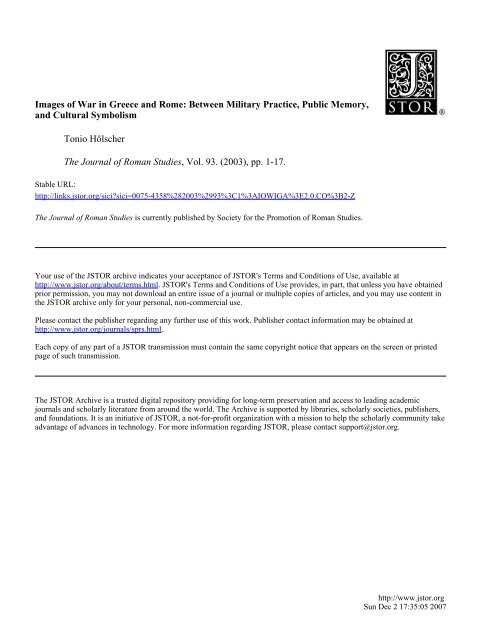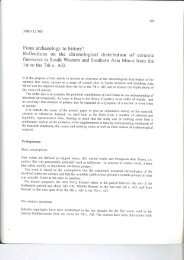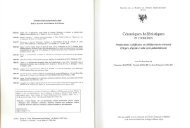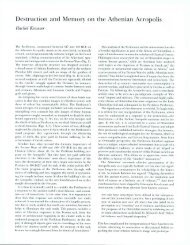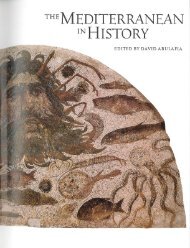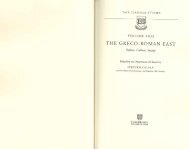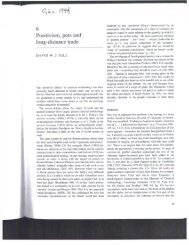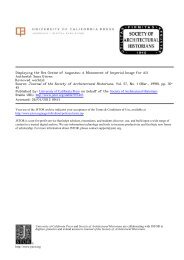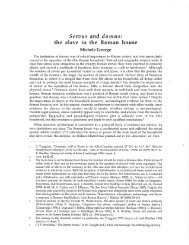Images of War in Greece and Rome: Between Military Practice ...
Images of War in Greece and Rome: Between Military Practice ...
Images of War in Greece and Rome: Between Military Practice ...
Create successful ePaper yourself
Turn your PDF publications into a flip-book with our unique Google optimized e-Paper software.
<strong>Images</strong> <strong>of</strong> <strong>War</strong> <strong>in</strong> <strong>Greece</strong> <strong>and</strong> <strong>Rome</strong>: <strong>Between</strong> <strong>Military</strong> <strong>Practice</strong>, Public Memory,<br />
<strong>and</strong> Cultural Symbolism<br />
Tonio Hölscher<br />
The Journal <strong>of</strong> Roman Studies, Vol. 93. (2003), pp. 1-17.<br />
Stable URL:<br />
http://l<strong>in</strong>ks.jstor.org/sici?sici=0075-4358%282003%2993%3C1%3AIOWIGA%3E2.0.CO%3B2-Z<br />
The Journal <strong>of</strong> Roman Studies is currently published by Society for the Promotion <strong>of</strong> Roman Studies.<br />
Your use <strong>of</strong> the JSTOR archive <strong>in</strong>dicates your acceptance <strong>of</strong> JSTOR's Terms <strong>and</strong> Conditions <strong>of</strong> Use, available at<br />
http://www.jstor.org/about/terms.html. JSTOR's Terms <strong>and</strong> Conditions <strong>of</strong> Use provides, <strong>in</strong> part, that unless you have obta<strong>in</strong>ed<br />
prior permission, you may not download an entire issue <strong>of</strong> a journal or multiple copies <strong>of</strong> articles, <strong>and</strong> you may use content <strong>in</strong><br />
the JSTOR archive only for your personal, non-commercial use.<br />
Please contact the publisher regard<strong>in</strong>g any further use <strong>of</strong> this work. Publisher contact <strong>in</strong>formation may be obta<strong>in</strong>ed at<br />
http://www.jstor.org/journals/sprs.html.<br />
Each copy <strong>of</strong> any part <strong>of</strong> a JSTOR transmission must conta<strong>in</strong> the same copyright notice that appears on the screen or pr<strong>in</strong>ted<br />
page <strong>of</strong> such transmission.<br />
The JSTOR Archive is a trusted digital repository provid<strong>in</strong>g for long-term preservation <strong>and</strong> access to lead<strong>in</strong>g academic<br />
journals <strong>and</strong> scholarly literature from around the world. The Archive is supported by libraries, scholarly societies, publishers,<br />
<strong>and</strong> foundations. It is an <strong>in</strong>itiative <strong>of</strong> JSTOR, a not-for-pr<strong>of</strong>it organization with a mission to help the scholarly community take<br />
advantage <strong>of</strong> advances <strong>in</strong> technology. For more <strong>in</strong>formation regard<strong>in</strong>g JSTOR, please contact support@jstor.org.<br />
http://www.jstor.org<br />
Sun Dec 2 17:35:05 2007
IMAGES OF WAR IN GREECE AND ROME: BETWEEN MILITARY<br />
PRACTICE, PUBLIC MEMORY, AND CULTURAL SYMBOLISM*<br />
(PLATES I-VI I)<br />
<strong>War</strong>s were once considered to be the essence <strong>of</strong> world history, but under the<br />
<strong>in</strong>fluence <strong>of</strong> social history, the histoire des mentalite's, <strong>and</strong> the discourse <strong>of</strong> the 'cultural<br />
turn' their role has changed fundamentally. More <strong>in</strong>terest is now paid to wars as part <strong>of</strong><br />
cultural history than as highpo<strong>in</strong>ts <strong>of</strong> histoire e'vtnementielle.<br />
Historians <strong>of</strong> the present generation st<strong>and</strong> <strong>in</strong> an ambivalent relation to the<br />
phenomenon <strong>of</strong> war. The 'cultural turn' <strong>in</strong> historical studies has generally focused on<br />
anthropological phenomena that are part <strong>of</strong> general human experience - love <strong>and</strong><br />
death, body <strong>and</strong> soul, memory <strong>and</strong> hope, customs <strong>and</strong> emotions, mentality <strong>and</strong><br />
ideologies. These phenomena, which are conceived as driv<strong>in</strong>g forces <strong>in</strong> history, are at<br />
the same time parts <strong>of</strong> the contemporary cultural furniture <strong>of</strong> those scholars who study<br />
their chang<strong>in</strong>g aspects as objects <strong>of</strong> research. The phenomenon <strong>of</strong> war, however, for the<br />
majority <strong>of</strong> contemporary historians <strong>and</strong> other observers <strong>in</strong> Europe <strong>and</strong> North America,<br />
has become a distant spectacle. So, what do we really know about war? And what do we<br />
want to know about war?<br />
S<strong>in</strong>ce the Second World <strong>War</strong>, our experiences <strong>of</strong> war <strong>and</strong> our attitudes to it have<br />
lacked def<strong>in</strong>ition. While there have been dozens <strong>of</strong> prolonged armed conflicts around<br />
the globe, most Europeans have lived for more than fifty years without the experience <strong>of</strong><br />
any real war. The elder generation still preserves the memory <strong>of</strong> war with<strong>in</strong> our own<br />
countries, but most <strong>of</strong> us have knowledge <strong>of</strong> contemporary wars only from television -<br />
that is, without any experience <strong>of</strong> imm<strong>in</strong>ent danger, fear, or death. The situation <strong>in</strong> the<br />
United States is even more ambivalent. It has been <strong>and</strong> is wag<strong>in</strong>g wars <strong>in</strong> distant parts<br />
<strong>of</strong> the world, send<strong>in</strong>g out its own soldiers who have then created great tensions with<strong>in</strong><br />
their own country -not only as victims but also as survivors. Soldiers returned home<br />
from Vietnam, for example, with horrify<strong>in</strong>g, unbelievable war experiences which it was<br />
almost impossible to <strong>in</strong>tegrate <strong>in</strong>to the imag<strong>in</strong>ation <strong>of</strong> a society driven by economic<br />
progress <strong>and</strong> welfare.<br />
In those decades the world also passed through a frighten<strong>in</strong>g period <strong>of</strong> cold war.<br />
Each nation had its own experiences but all were <strong>in</strong>volved <strong>in</strong> a massive effort <strong>of</strong><br />
ideological self-assertion. The lead<strong>in</strong>g powers <strong>of</strong> the world constructed a political<br />
identity <strong>in</strong> emphatic opposition to 'the great enemy': West aga<strong>in</strong>st East, <strong>and</strong> vice versa.<br />
This oppositional political identity was <strong>in</strong>tensified by totaliz<strong>in</strong>g ideologies <strong>of</strong> opposite<br />
economies <strong>and</strong> cultures.<br />
After the breakdown <strong>of</strong> the communist world <strong>in</strong> 1989, the surviv<strong>in</strong>g western world<br />
faced an identity problem. The old political <strong>and</strong> ideological oppositions had become<br />
secondary, <strong>and</strong> economic globalization seemed to have dissolved the political boundaries<br />
<strong>of</strong> identity. For a short time it could be questioned if the old model would cont<strong>in</strong>ue to<br />
predom<strong>in</strong>ate - the model <strong>of</strong> precisely def<strong>in</strong>ed political identity constructed from<br />
* I thank R. R. R. Smith for <strong>in</strong>vit<strong>in</strong>g me to give a Franssen, William Harris <strong>and</strong> Emanuel Mayer. To<br />
conclud<strong>in</strong>g overview <strong>in</strong> a sem<strong>in</strong>ar series <strong>in</strong> Oxford on Susanne Muth <strong>and</strong> Felix Pirson who read the text I<br />
'Art <strong>and</strong> <strong>War</strong> <strong>in</strong> the Ancient World', for recom- owe many useful <strong>and</strong> stimulat<strong>in</strong>g contributions. The<br />
mend<strong>in</strong>g the paper to the editors <strong>of</strong> this journal, <strong>and</strong> part <strong>of</strong> Fern<strong>and</strong>e Holscher with whom I discussed<br />
for correct<strong>in</strong>g <strong>and</strong> angliciz<strong>in</strong>g my text. I also thank most <strong>of</strong> these issues is hard to def<strong>in</strong>e.<br />
the Journal's anonymous readers for their precise The illustrations are courtesy <strong>of</strong> the Archaeolo-<br />
comments. For helpful criticism <strong>and</strong> suggestions I am gical Institute, University <strong>of</strong> Heidelberg.<br />
grateful to Bett<strong>in</strong>a Bergmann, Barbara Borg, Jiirgen<br />
O World copyright reserved. Exclusive Licence to Publish: The Society for the Promotion <strong>of</strong> Roman Studies<br />
2003.
precisely def<strong>in</strong>ed enmity <strong>and</strong> hostility enhanced by aggressive ideology <strong>and</strong> propag<strong>and</strong>a.<br />
Formerly Western societies had their traditional enemies (<strong>in</strong> Germany 'the French',<br />
later 'the Russians'), but what was an enemy, what was political identity to become <strong>in</strong><br />
the world <strong>of</strong> globalization? If political conflicts were to develop without precisely<br />
def<strong>in</strong>ed enemies <strong>and</strong> so become more complex, did they not also require more complex<br />
solutions?<br />
To avoid such questions, the most far-reach<strong>in</strong>g <strong>and</strong> complex conflicts <strong>in</strong> the world<br />
at the moment, particularly those between the Western <strong>and</strong> the Islamic worlds, are<br />
reduced <strong>and</strong> personalized by lead<strong>in</strong>g Western politicians to a fight aga<strong>in</strong>st <strong>in</strong>dividual<br />
foes <strong>and</strong> clearly def<strong>in</strong>ed small groups <strong>of</strong> terrorist enemies. At the same time, these<br />
conflicts are conceived <strong>in</strong> terms <strong>of</strong> a simple ideological antithesis - between self-<br />
evidently positive Western values <strong>and</strong> foreign cultures full <strong>of</strong> dangerous <strong>and</strong> aggressive<br />
attitudes. This seems to be a deliberate withdrawal from the requirements <strong>of</strong> complex<br />
structural politics, <strong>and</strong> it results <strong>in</strong> an almost archaic concept <strong>of</strong> fight <strong>and</strong> battle. This<br />
simplistic <strong>and</strong> frighten<strong>in</strong>g stratagem is obviously well-suited to rouse collective emotions<br />
<strong>in</strong> favour <strong>of</strong> wag<strong>in</strong>g war <strong>in</strong> a society that is not so much concerned with the complex<br />
cultural <strong>and</strong> economic situations <strong>of</strong> other societies as with its own political <strong>and</strong> economic<br />
<strong>in</strong>terests. The stratagem aga<strong>in</strong> divides the world conveniently <strong>in</strong>to 'good' <strong>and</strong> 'bad'. The<br />
dangers <strong>of</strong> such anachronistic <strong>and</strong> simplistic th<strong>in</strong>k<strong>in</strong>g are evident. And it is <strong>in</strong> this<br />
context that it is urgent to f<strong>in</strong>d proper historical concepts for underst<strong>and</strong><strong>in</strong>g war.<br />
<strong>War</strong> <strong>in</strong> art is not war but art. It is a view, or a spectrum <strong>of</strong> views, <strong>of</strong> war seen<br />
through the medium <strong>of</strong> the visual arts - a mental <strong>and</strong> visual construct <strong>in</strong> a medium<br />
with its own specific possibilities <strong>and</strong> rules. This does not make the study <strong>of</strong> 'war <strong>in</strong> art'<br />
any less <strong>in</strong>terest<strong>in</strong>g or challeng<strong>in</strong>g. The images <strong>of</strong> war <strong>in</strong> all cultures are no mere visual<br />
fictions: they refer to hard, pr<strong>of</strong>ound, <strong>and</strong> complex experiences <strong>in</strong> real life, to a world <strong>of</strong><br />
kill<strong>in</strong>g <strong>and</strong> dy<strong>in</strong>g. A large part <strong>of</strong> the human <strong>and</strong> historical significance <strong>of</strong> wars thus lies<br />
not so much <strong>in</strong> their factual results (collective victory or defeat, <strong>in</strong>dividual triumph or<br />
death) as <strong>in</strong> the emotional, ethical, <strong>and</strong> ideological experiences <strong>and</strong> concepts connected<br />
with war <strong>and</strong> warfare. That is, a large part <strong>of</strong> the relevance <strong>of</strong> war <strong>in</strong> history lies <strong>in</strong><br />
mentally constructed behaviour <strong>and</strong> perceptions. In this respect images are a highly<br />
reveal<strong>in</strong>g form <strong>of</strong> historical evidence: whether they confirm or complement written<br />
texts, they constitute an autonomous world <strong>of</strong> visual experience.'<br />
Some basic theoretical premises for what follows can be briefly described.' Firstly,<br />
all artistic images are <strong>of</strong> course mental constructs. As far as they represent the world <strong>of</strong><br />
reality, they select specific subjects <strong>and</strong> motifs relevant for their purpose, focus on<br />
particular aspects <strong>of</strong> them, <strong>and</strong> enhance the expressive power <strong>of</strong> those chosen aspects.<br />
<strong>Images</strong> are thus reflections <strong>of</strong> cultural imag<strong>in</strong>ation. Secondly, reality too is a construct.<br />
The reality <strong>of</strong> war is determ<strong>in</strong>ed <strong>and</strong> formed by particular technical conditions -arms<br />
<strong>and</strong> armour, logistical equipment, tactical <strong>and</strong> strategic concepts, patterns <strong>of</strong> behaviour<br />
<strong>and</strong> social ideals. Such conditions affect fundamentally the concrete <strong>and</strong> visual conduct<br />
<strong>of</strong> fight<strong>in</strong>g. Reality <strong>in</strong> this sense is an image. Thirdly, the perception <strong>of</strong> reality is also a<br />
construct. A war or a battle can be perceived, for example, as a collective enterprise or<br />
as a series <strong>of</strong> <strong>in</strong>dividual achievements, as a glorious event or as a theatre <strong>of</strong> suffer<strong>in</strong>g <strong>and</strong><br />
death. Perception <strong>in</strong> this sense creates images. And f<strong>in</strong>ally, such mental constructs are<br />
determ<strong>in</strong>ed by cultural circumstances, specific to <strong>in</strong>dividual societies <strong>in</strong> different<br />
historical periods. S<strong>in</strong>ce such cultural constructs operate <strong>in</strong> different media - <strong>in</strong> the<br />
concrete world <strong>of</strong> real life, <strong>in</strong> psychological perception, <strong>and</strong> <strong>in</strong> visual representations -<br />
they necessarily result <strong>in</strong> phenomena <strong>of</strong> different form <strong>and</strong> appearance. But <strong>in</strong> so far as<br />
they are produced by the same society, they will have some basic features <strong>in</strong> common.<br />
This underly<strong>in</strong>g pr<strong>in</strong>ciple can be termed a society's specific cultural 'habit~s'.~<br />
' L. Hannestad, '<strong>War</strong> <strong>and</strong> Greek art', 120-9, <strong>and</strong> For the follow<strong>in</strong>g theoretical approach see:<br />
N. Hannestad, '<strong>War</strong>fare <strong>in</strong> Roman imperial art', T. HBlscher, Formen der Kunst und Formen des Lebens<br />
146-54, <strong>in</strong> T. Bekker-Nielsen <strong>and</strong> L. Hannestad (1995), 11~45.<br />
(eds), <strong>War</strong> as a Cultural <strong>and</strong> Social Force, Kongelige On social structures <strong>and</strong> habitus: P. Bourdieu,<br />
Danske Videnskabernes Selskab, Historisk-filos<strong>of</strong>iske Outl<strong>in</strong>e <strong>of</strong> a Theory <strong>of</strong> <strong>Practice</strong> (1977).<br />
Skrifter 22 (2001).
IMAGES OF WAR IN GREECE AND ROME<br />
A brief look at two battle scenes from Greek <strong>and</strong> Roman art can demonstrate<br />
quickly the constructed character <strong>of</strong> ancient representations <strong>of</strong> war.<br />
An Attic black-figure cup from the first half <strong>of</strong> the sixth century B.C. (Pl. I, I)<br />
represents a battle scene as a sequence <strong>of</strong> three duels, each between two warriors,<br />
equipped with shields <strong>and</strong> huge helmets <strong>and</strong> fight<strong>in</strong>g with long lance^.^ At first glance,<br />
it is easy to see that several features <strong>in</strong> this picture lack realism. S<strong>in</strong>ce battles <strong>in</strong> archaic<br />
<strong>Greece</strong> were fought - ideally <strong>and</strong> <strong>in</strong> some degree <strong>in</strong> reality - <strong>in</strong> close formations <strong>of</strong><br />
soldiers (the phalanx), combat <strong>in</strong> duels does not correspond to the reality <strong>of</strong> archaic<br />
warfare. Moreover, the nude bodies <strong>and</strong> light tunics <strong>of</strong> the warriors were not the normal<br />
equipment <strong>of</strong> Greek hoplites. Scholars have <strong>in</strong>terpreted these features as an idealization<br />
<strong>of</strong> aristocratic warfare. They are taken as anachronistic, designed to refer back to<br />
Homeric ideals, <strong>and</strong> to elevate contemporary warriors to the sphere <strong>of</strong> heroes. Although<br />
each <strong>of</strong> these <strong>in</strong>terpretations may be questioned, there can be no doubt that the image is<br />
a visual construct.<br />
Realistic battle-scenes on the other h<strong>and</strong> seem to be a doma<strong>in</strong> <strong>of</strong> Roman art -<br />
especially the reliefs on imperial arches, on the great battle sarcophagi, <strong>and</strong> on the<br />
columns <strong>of</strong> Trajan <strong>and</strong> Marcus Aurelius. A dramatic battle between massed forces is<br />
represented <strong>in</strong> a scene on Trajan's Column (Pl. 11, 1-2). Roman units attack <strong>in</strong> closed<br />
formation from the left <strong>and</strong> put their enemies, the Dacians, to flight towards the right.<br />
Opponents are dist<strong>in</strong>guished by their ethnic physiognomies <strong>and</strong> their equipment.' This<br />
is a set-piece battle with two armies clearly ranged aga<strong>in</strong>st each other <strong>in</strong> space, with<br />
clearly marked cultural dist<strong>in</strong>ctions between the two sides, <strong>and</strong> with many military <strong>and</strong><br />
episodic details which give the scene the character <strong>of</strong> immediate realism.<br />
The contrast between battle-scenes from archaic <strong>Greece</strong> <strong>and</strong> imperial <strong>Rome</strong> seems<br />
to conform perfectly to the received idea <strong>of</strong> Greek idealism <strong>and</strong> Roman realism, <strong>in</strong> art as<br />
<strong>in</strong> other sectors <strong>of</strong> culture. There are reasons however for re-consider<strong>in</strong>g this contrast.<br />
Firstly, we might consider the viewers <strong>of</strong> these works <strong>of</strong> art. All potential users <strong>of</strong><br />
archaic dr<strong>in</strong>k<strong>in</strong>g-cups were members <strong>of</strong> the lead<strong>in</strong>g class <strong>of</strong> their respective polis <strong>and</strong> as<br />
such potential members <strong>of</strong> their polis's army. They all had, or expected to have, real<br />
experience <strong>of</strong> war. They knew about what they were look<strong>in</strong>g at. Conversely, among the<br />
audience <strong>of</strong> public monuments <strong>in</strong> imperial <strong>Rome</strong>, such as Trajan's Column, few would<br />
ever have witnessed real warfare.<br />
The expectations <strong>of</strong> different viewers need not <strong>of</strong> course have determ<strong>in</strong>ed the<br />
degree <strong>of</strong> realism <strong>in</strong> these representations <strong>of</strong> war.6 We might ask however whether <strong>and</strong><br />
how far such circumstances affected the way <strong>in</strong> which war was conceived <strong>in</strong> images. We<br />
might expect that those who actually participated <strong>in</strong> war (for example, the cup users)<br />
wanted or claimed to recognize someth<strong>in</strong>g that corresponded to their real experiences.<br />
This need not be a representation <strong>of</strong> 'objective reality' <strong>and</strong> might as easily be an<br />
ideological construction designed to give their achievements <strong>in</strong>dividual <strong>and</strong> collective<br />
value. But even such ideologically shaped images should probably refer recognizably to<br />
real aspects <strong>of</strong> war that the participants had themselves experienced. In the case <strong>of</strong> non-<br />
participants (for example, the viewers <strong>of</strong> Trajan's Column), the distance between them<br />
<strong>and</strong> the military action represented naturally encouraged more explicit ideological<br />
<strong>in</strong>terpretations <strong>of</strong> war <strong>and</strong> military conquest. In this context, however, a concerted effort<br />
was <strong>of</strong>ten made also to visualize <strong>in</strong> detail achievements that had taken place far from the<br />
spectators' own experience. Such images worked to exemplify an ideology <strong>of</strong> victory by<br />
present<strong>in</strong>g factual-look<strong>in</strong>g evidence.<br />
We should leave aside therefore preconceived ideas about 'idealism' <strong>and</strong> 'realism'<br />
<strong>and</strong> be prepared for a great variety <strong>of</strong> perceptions <strong>of</strong> war <strong>and</strong> warfare. It was through<br />
ABV 52, 10; H. A. G. Brijder, Siana Cups I <strong>and</strong> Emmanuel Mayer rem<strong>in</strong>ds me <strong>of</strong> the reactions to<br />
Comast Cups (1983), pls 9b, 23a; Chr. Ell<strong>in</strong>ghaus, the First World <strong>War</strong> <strong>in</strong> Germany: immediately after<br />
Aristokratische Leitbilder - demokratische Leitbilde~. the war the surviv<strong>in</strong>g soldiers kept highly idealiz<strong>in</strong>g<br />
Kampfdarstellungen auf athenischen Vasen zn memories <strong>of</strong> their experiences, <strong>and</strong> more critical <strong>and</strong><br />
archaischer und friihklassischer Zeit (1997), 12-13. 'realistic' accounts were produced only later -such<br />
K. Lehmann-Hartleben, Die Trajanssaule (1923), as E. M. Remarque's Im Westen nichts Neues, first<br />
Taf. 14, 23, 34; F. Coarelli, La colonna traiana published <strong>in</strong> 1929.<br />
(1999), tav. 21-4,42-5,81-3.<br />
3
such highly varied perceptions that military reality <strong>and</strong> ideological concepts were made<br />
to relate to each other, <strong>in</strong> specific <strong>and</strong> shift<strong>in</strong>g ways.<br />
Four basic aspects <strong>of</strong> war <strong>in</strong> ancient art may be s<strong>in</strong>gled out for <strong>in</strong>vestigation. Each<br />
br<strong>in</strong>gs out some general features <strong>of</strong> Greek <strong>and</strong> Roman culture.<br />
(I) <strong>War</strong> <strong>and</strong> fight<strong>in</strong>g as military activity. In the mirror <strong>of</strong> art, this concerns the<br />
psychological experience <strong>of</strong> war, that is, <strong>of</strong> threat, violence, <strong>and</strong> death.<br />
(2) <strong>War</strong> as the construction <strong>of</strong> political dichotomies. <strong>War</strong> def<strong>in</strong>es oppositions<br />
between one subject group <strong>and</strong> others, <strong>and</strong> between a collective self <strong>and</strong> a collective<br />
enemy. It is the most extreme form <strong>of</strong> realiz<strong>in</strong>g identity <strong>and</strong> otherness.<br />
(3) <strong>War</strong> as legitimized kill<strong>in</strong>g. <strong>War</strong> entails a collectively def<strong>in</strong>ed <strong>and</strong> legitimized<br />
transfer from life to death. This aspect takes us <strong>in</strong>to the sphere <strong>of</strong> cultural<br />
anthropology.<br />
(4) <strong>War</strong> <strong>in</strong> public memory. Public monuments produced to memorialize war are<br />
concerned with its ideological exploitation as a foundation <strong>of</strong> political power.<br />
These aspects <strong>of</strong> war can be considered as cultural phenomena <strong>in</strong> various contexts from<br />
a distanced. com~arative ~o<strong>in</strong>t<strong>of</strong> view. This article thus draws material from the Greek<br />
as well as the Roman world not <strong>in</strong> order to present a magnificent panorama but to<br />
sharpen the eye to specific differences between these ancient societies <strong>and</strong> to br<strong>in</strong>g out<br />
the otherness(es) <strong>of</strong> antiquity <strong>in</strong> comparison with contemporary experiences. To lay out<br />
such ideas briefly, <strong>in</strong>stead <strong>of</strong> <strong>in</strong> a book, means <strong>in</strong>evitably a lack <strong>of</strong> nuance, <strong>of</strong> which I am<br />
here conscious.<br />
Modes <strong>of</strong> Combat<br />
11. MILITARY REALITY AND PSYCHOLOGICAL EXPERIENCE<br />
Archaic battles were conceived as a fight between compact phalanxes. The army<br />
arrayed for battle <strong>and</strong> its manner <strong>of</strong> fight<strong>in</strong>g embodied an ideal <strong>of</strong> civic coherence <strong>and</strong><br />
generated a dist<strong>in</strong>ctive spirit <strong>of</strong> practical <strong>and</strong> ethical solidarity <strong>and</strong> homogeneity which<br />
had its social equivalent <strong>in</strong> the ideal <strong>of</strong> homoiotes, equality among the polis's citizens. In<br />
art, this ideal <strong>of</strong> the compact citizen phalanx is represented, for example, <strong>in</strong> one <strong>of</strong> the<br />
friezes <strong>of</strong> the famous Chigi jug (Pl. I, 2), where impressive <strong>and</strong> coherent files <strong>of</strong> soldiers<br />
repeat the same type <strong>of</strong> ~arrior.~<br />
Whereas archaic art was thus fully capable <strong>of</strong> depict<strong>in</strong>g such collective units, this<br />
was evidently not how battles were normally perceived, as the great majority <strong>of</strong> archaic<br />
vases that represent battles as a series <strong>of</strong> duels attests (Pl. I, I). S<strong>in</strong>gle combats dom<strong>in</strong>ate<br />
even <strong>in</strong> large, developed compositions, such as that on an o<strong>in</strong>tment pot <strong>in</strong> Paris (Pl. V,<br />
I).' The traditional historian's question whether these representations are or are not<br />
faithful evidence <strong>of</strong> archaic warfare is mislead<strong>in</strong>g. The well-known answer that they<br />
present an idealiz<strong>in</strong>g stylization <strong>of</strong> warfare <strong>in</strong> terms <strong>of</strong> Homeric concepts <strong>of</strong> heroic<br />
valour does not address how such representations were compatible with the reality <strong>of</strong><br />
contemporary wars. S<strong>in</strong>ce these depictions must be evidence <strong>of</strong> how fight<strong>in</strong>g was actually<br />
conceived <strong>and</strong> also at some level how it was experienced, we should rather ask how these<br />
representations relate to military practice <strong>and</strong> how we should expla<strong>in</strong> the fact that<br />
fight<strong>in</strong>g <strong>in</strong> war was experienced <strong>in</strong> this form.9<br />
E. Simon <strong>and</strong> M. Hirmer, Die griechischen Vasen izzazione militare', <strong>in</strong> S. Settis (ed.), I Greci (1996),<br />
(1976), Taf. 58; H. van Wees, 'The development <strong>of</strong> ' I1 I, 681-714.<br />
the hoplite phalanx: iconography <strong>and</strong> reality <strong>in</strong> the ABV 58, 122; Simon <strong>and</strong> Hirmer, op. cit. (n. 7),<br />
7th century', <strong>in</strong> H. van Wees (ed.), <strong>War</strong> <strong>and</strong> Violence Taf. 58.<br />
<strong>in</strong> Ancient <strong>Greece</strong> (zooo), 125-66. Generally on the I do not agree, <strong>in</strong> this specific regard, with the<br />
phalanx <strong>in</strong> vase-pa<strong>in</strong>t<strong>in</strong>g, see H. L. Lorimer, 'The scepticism <strong>of</strong> P. Cartledge on the value <strong>of</strong> representa-<br />
hoplite phalanx', BSA 42 (1947)~ 76-138. On the tions <strong>of</strong> war <strong>in</strong> art, p. 712 <strong>of</strong> his admirable article, op.<br />
orig<strong>in</strong>s <strong>of</strong> the phalanx tactic, see the balanced discus- cit. (n. 7).<br />
sion <strong>in</strong> P. Cartledge, 'La nascita degli opliti e l'organ-
IMAGES OF WAR IN GREECE AND ROME<br />
5<br />
Evidently the experience <strong>of</strong> collective fight<strong>in</strong>g lost some <strong>of</strong> its importance at the<br />
moment the phalanxes clashed with each other <strong>and</strong> the soldiers began to fight.10<br />
Precisely this moment is shown on the Macmillan oil-flask <strong>in</strong> the British Museum (Pl.<br />
I, 3) on which coherent attack<strong>in</strong>g phalanxes are shown on one side <strong>and</strong> s<strong>in</strong>gle groups <strong>of</strong><br />
fight<strong>in</strong>g hoplites on the other." In order to underst<strong>and</strong> such an image as a representation<br />
<strong>of</strong> real psychological experience, we need to remember that <strong>in</strong> archaic warfare there was<br />
almost no collective strategy <strong>in</strong> which the <strong>in</strong>dividual soldier was merely one element.<br />
The leader <strong>of</strong> the army <strong>in</strong> fact played a very restricted role: he had to l<strong>in</strong>e up the phalanx<br />
<strong>in</strong> good order <strong>and</strong> to give the signal for attack, not much more. Close formation had to<br />
be kept dur<strong>in</strong>g the advance, but once jo<strong>in</strong>ed the battle was primarily between s<strong>in</strong>gle<br />
warriors with few neighbours <strong>and</strong> few adversaries. The isolation <strong>of</strong> the <strong>in</strong>dividual<br />
warrior was enhanced by the design <strong>of</strong> archaic helmets - especially that used most<br />
frequently the 'Cor<strong>in</strong>thian' helmet with its small eye-slots which allowed no broad view<br />
around but concentrated its wearer's eyes exclusively on his immediate opponent.12<br />
Noth<strong>in</strong>g beyond this face-to-face encounter would be perceived. And this was surely a<br />
dom<strong>in</strong>ant experience <strong>of</strong> early Greek warfare -<strong>in</strong> spite <strong>of</strong> the conceptual coherence <strong>of</strong><br />
the phalanx. Accord<strong>in</strong>g to Thucydides, 'those who are present (<strong>in</strong> a battle) do not know<br />
everyth<strong>in</strong>g that happens, but each man knows barely what happens near himself'.13<br />
This archaic battle style became an all-embrac<strong>in</strong>g ideology <strong>of</strong> agonistic excellence<br />
enhanced by Homeric ideals <strong>of</strong> valour. Close fight<strong>in</strong>g with lances was valued as the only<br />
real pro<strong>of</strong> <strong>of</strong> arete, <strong>in</strong> contrast to the contemptible fight<strong>in</strong>g <strong>of</strong> archers from a distance<br />
with bow <strong>and</strong> arrow.14 This conception <strong>of</strong> face-to-face fight<strong>in</strong>g was thus at the same<br />
time a compell<strong>in</strong>g ideal <strong>of</strong> manly excellence <strong>and</strong> a vital experience <strong>of</strong> reality. It is<br />
expressed <strong>in</strong> the <strong>in</strong>numerable compositions <strong>of</strong> duel <strong>and</strong> group fight<strong>in</strong>g <strong>in</strong> Greek art.<br />
There may be <strong>in</strong> the experience <strong>and</strong> representation <strong>of</strong> warfare an <strong>in</strong>herent ambivalence<br />
between the <strong>in</strong>dividual <strong>and</strong> the collectivity, but <strong>in</strong> early Greek art this ambivalence is<br />
particularly sharply expressed. Both k<strong>in</strong>ds <strong>of</strong> representation - collective battle<br />
formations <strong>and</strong> s<strong>in</strong>gle duels - are neither correct nor <strong>in</strong>correct versions <strong>of</strong> military<br />
reality. They are complementary views <strong>of</strong> the same reality, <strong>and</strong> <strong>in</strong> this sense they are<br />
legitimate representations <strong>of</strong> real experiences.<br />
This phenomenon can be generalized. Face-to-face <strong>in</strong>teraction corresponds to a<br />
basic structure <strong>of</strong> early Greek societie~.'~ In the community <strong>of</strong> the polis, the most<br />
important collective activities - the political decisions <strong>in</strong> the citizens' assembly, the<br />
rituals <strong>of</strong> religious festivities, the contests <strong>of</strong> athletic <strong>and</strong> musical agones - were<br />
occasions <strong>of</strong> <strong>in</strong>tensive personal <strong>in</strong>teraction <strong>and</strong> confrontation, face to face. Individual<br />
activities <strong>and</strong> experiences were not subjected to major, collective actions <strong>of</strong> higher<br />
relevance. In the same way, early Greek figurative art, <strong>in</strong>dependent <strong>of</strong> specific themes,<br />
is determ<strong>in</strong>ed by a particular conception <strong>of</strong> space <strong>and</strong> action based on the s<strong>in</strong>gle person<br />
<strong>and</strong> his immediate potential for action. There is no cont<strong>in</strong>uous space <strong>in</strong> which <strong>in</strong>dividual<br />
actions are subord<strong>in</strong>ated to a comprehensive whole. All actions are represented as<br />
deal<strong>in</strong>g with immediate partners or opponents, <strong>and</strong> so are limited <strong>in</strong> space to the reach<br />
<strong>of</strong> the persons' limbs, implements, <strong>and</strong> weapons. In the realms <strong>of</strong> social life <strong>and</strong> visual<br />
lo See T. Holscher, Griechische Historienbilder des 5. Hoplites. The Classical Greek Battle Experience (1991),<br />
und 4.Jahrhunderts o.Chr. (1973), 28-30; A. Stewart, 63-84; J. Lazenby, 'The kill<strong>in</strong>g zone', <strong>in</strong> ibid.,<br />
Art, Desire, <strong>and</strong> the Body (1997), 89-93; van Wees, 87-120, esp. 93-102.<br />
op. cit. (n. 7). l3 Thucydides 7.44.1 (trans. C. F. Smith, Loeb<br />
l1 C. Smith, 'A protocor<strong>in</strong>thian lekythos <strong>in</strong> the Brit- Class. Library).<br />
ish Museum', JHS 11 (18go), 167-80, withpl. 11. See l4 On the ideal <strong>of</strong> <strong>in</strong>dividual fight<strong>in</strong>g, face to face, see<br />
Cartledge, op. cit. (n. 7), 689, on Homer's emphasis for example Homer, Iliad 2.604; Euripides, Rhesos<br />
on s<strong>in</strong>gle duels with<strong>in</strong> the frame <strong>of</strong> mass battles: 510-1 I. Lance aga<strong>in</strong>st bow: Homer, Iliad I I ,384-90;<br />
'L'importanza apparentemente fondamentale dei Archilochos Fr. 3 Diehl = fr. 3 West; Strabo I I. I. I 2;<br />
duelli tra s<strong>in</strong>goli eroi e un'illusione creata col ricorso Holscher, op. cit. (n. IO), 42-3, 154; Cartledge, op.<br />
dei poeti all'espediente quasi "c<strong>in</strong>ematografico" della cit. (n. 7), 699-700, on Thucydides 4.40 <strong>and</strong> 'ideologia<br />
messa a fuoco o dello zoom sulla s<strong>in</strong>golare tenzone dei oplitica'.<br />
protagonisti a f<strong>in</strong>i drammatico-narrativi.' See recently IS See Chr. Meier, Politik und Anmut (2000);<br />
0. Hellmann, Die Schlachtszenen der Ilias, Hermes T. Holscher, '<strong>Images</strong> <strong>and</strong> political identity. The case<br />
E<strong>in</strong>zelschriften 83 (2000). <strong>of</strong> Athens', <strong>in</strong> D. Boedeker <strong>and</strong> K. Raaflaub (eds),<br />
'Z See V. D. Hanson, The Western Way <strong>of</strong> <strong>War</strong> Democracy, Empire <strong>and</strong> the Arts <strong>in</strong> Fifth Century<br />
(1989), esp. 19-26, 71-5, 135-59; idem, 'Hoplite Athens (1998), 353-85.<br />
technology <strong>in</strong> phalanx battle', <strong>in</strong> V. D. Hanson (ed.),
epresentation, we may def<strong>in</strong>e early Greek culture <strong>in</strong> this way as a culture <strong>of</strong> immediate<br />
<strong>and</strong> autonomous action <strong>and</strong> <strong>in</strong>teraction.<br />
From the Hellenistic period the conception <strong>of</strong> relatively autonomous fight<strong>in</strong>g is<br />
superseded <strong>in</strong> art by new structures <strong>of</strong> composition, which aga<strong>in</strong> correspond to specific<br />
concepts <strong>of</strong> military strategy. The first <strong>and</strong> best example is the Alex<strong>and</strong>er mosaic from<br />
Pompeii, a reliable version <strong>of</strong> an early hellenistic pa<strong>in</strong>t<strong>in</strong>g, represent<strong>in</strong>g a victorious<br />
battle <strong>of</strong> Alex<strong>and</strong>er the Great aga<strong>in</strong>st the Persians (Pl. 111, I).'~The oppos<strong>in</strong>g armies<br />
are clearly dist<strong>in</strong>guished by their equipment as well as their configuration <strong>in</strong> space.<br />
Alex<strong>and</strong>er charges from the left <strong>in</strong>to the centre <strong>of</strong> the Persian army followed by his<br />
companion cavalry who are depicted <strong>in</strong> highly <strong>in</strong>dividualized actions. The Great K<strong>in</strong>g<br />
<strong>in</strong> his chariot turns to flight at the last moment. while some <strong>of</strong> his most devoted subiects<br />
throw themselves despeyately <strong>in</strong> the aggressors' way. The soldiers around the re at<br />
K<strong>in</strong>g are seized with fear <strong>and</strong> despair, <strong>and</strong> others are brutally run over by his chariot<br />
<strong>and</strong> horses, while <strong>in</strong> the background a (probably) Greek detachment with long lances<br />
surrounds the Persian centre. Each <strong>in</strong>dividual action is made to relate to the action <strong>of</strong><br />
the whole, far beyond the reach <strong>of</strong> any <strong>in</strong>dividual combatant. All the figures participate<br />
<strong>in</strong> <strong>and</strong> contribute to a collective event which is more than the sum <strong>of</strong> its s<strong>in</strong>gle elements.<br />
In a general way this composition corresponds clearly to the development <strong>of</strong><br />
military strategy <strong>in</strong> the fourth century <strong>and</strong> later. This is best documented <strong>in</strong> the case <strong>of</strong><br />
Alex<strong>and</strong>er the Great. Alex<strong>and</strong>er used the units <strong>of</strong> his army like chess-figures <strong>in</strong> a<br />
strategic plan <strong>in</strong> which all parts had different tasks <strong>and</strong> movements <strong>and</strong> were coord<strong>in</strong>ated<br />
<strong>in</strong> a complex collective enterprise. The physical reality <strong>of</strong> kill<strong>in</strong>g <strong>and</strong> dy<strong>in</strong>g<br />
cannot have changed fundamentally, but as units <strong>and</strong> <strong>in</strong>dividual soldiers became tools<br />
with<strong>in</strong> an overall strategic plan, so the experience <strong>of</strong> autonomous fight<strong>in</strong>g <strong>and</strong> <strong>in</strong>dividual<br />
glory would have been correspond<strong>in</strong>gly reduced. This does not imply <strong>of</strong> course that the<br />
picture is a realistic depiction <strong>of</strong> a specific battle. The crucial po<strong>in</strong>t is that the strategic<br />
plan <strong>and</strong> the artistic composition are guided by an analogous conception <strong>of</strong> the role <strong>of</strong><br />
the <strong>in</strong>dividual person with<strong>in</strong> a comprehensive whole.<br />
This new conception <strong>of</strong> space seems aga<strong>in</strong> to be <strong>of</strong> wider importance. It corresponds<br />
to an experience <strong>of</strong> the world <strong>in</strong> which each <strong>in</strong>dividual performs his own actions <strong>and</strong><br />
experiences his own dest<strong>in</strong>y but one <strong>in</strong> which those <strong>in</strong>dividual actions <strong>and</strong> experiences<br />
were also conceived as part <strong>of</strong> a comprehensive network <strong>of</strong> <strong>in</strong>terdependent elements. In<br />
a prelim<strong>in</strong>ary generaliz<strong>in</strong>g way, this phenomenon, which needs thorough <strong>in</strong>vestigation,<br />
may be conceived as characteristic <strong>of</strong> the Hellenistic world. The <strong>in</strong>tegration <strong>of</strong><br />
autonomous cities <strong>and</strong> autonomous citizens <strong>in</strong>to large territorial states ruled by distant<br />
k<strong>in</strong>gs <strong>and</strong> their subord<strong>in</strong>ation to large-scale changes <strong>and</strong> processes must have created a<br />
psychological situation <strong>in</strong> which the <strong>in</strong>dividual felt to a considerable degree dependent<br />
on major forces <strong>and</strong> on a k<strong>in</strong>d <strong>of</strong> general dest<strong>in</strong>y or Tyche that was more than personal<br />
fate. Hellenistic warfare may be seen <strong>in</strong> this perspective as a symptom <strong>of</strong> this general<br />
situation.<br />
Similar compositions can be seen <strong>in</strong> Roman reliefs such as the great battle scenes<br />
on Trajan's Column. The Romans attack <strong>and</strong> the Dacians retreat <strong>in</strong> coherent group<br />
formations, <strong>and</strong>, beh<strong>in</strong>d the Roman front l<strong>in</strong>e, the emperor receives the cut-<strong>of</strong>f heads <strong>of</strong><br />
enemies killed (Pl. 11, 1-2). S<strong>in</strong>gle figures <strong>and</strong> military units are aga<strong>in</strong> conceived as<br />
factors <strong>in</strong> a collective endeavour which transcends the autonomv <strong>of</strong> <strong>in</strong>dividual actions.<br />
In precisely the same period, however, a new conception <strong>of</strong> imperial warfare is<br />
represented <strong>in</strong> the Great Trajanic Frieze. The frieze belonged orig<strong>in</strong>ally to an unknown<br />
monument <strong>of</strong> Trajan <strong>and</strong> was re-used <strong>in</strong> the Arch <strong>of</strong> Constant<strong>in</strong>e." The general<br />
composition follows the pr<strong>in</strong>ciple <strong>of</strong> mass fight<strong>in</strong>g <strong>in</strong> coherent units: the Romans attack<br />
from the left <strong>and</strong> overrun the helpless Dacian enemies on the right. But the emperor<br />
himself appears at the head <strong>of</strong> the attack<strong>in</strong>g force. This is <strong>of</strong> course not the realistic<br />
motif it was on the Alex<strong>and</strong>er mosaic. Roman emperors <strong>and</strong> their generals, unlike<br />
l6 B. Andreae, Das Alex<strong>and</strong>ermosaik aus Pompeji l7 M. L. Le<strong>and</strong>er Touati, The Great Trajanic Frieze<br />
(1977). For the specific aspects <strong>of</strong> space <strong>and</strong> action see (1987), pls 1-4, 56; B. A. Andreae, Romische Kunst<br />
Htilscher, op. cit. (n. IO), 162-9; Holscher, op. cit. (1973), Abb. 421-4.<br />
(n. 2), 30-6.<br />
-
IMAGES OF WAR IN GREECE AND ROME 7<br />
Hellenistic k<strong>in</strong>gs, never played the role <strong>of</strong> personal leaders <strong>of</strong> their troops <strong>in</strong> battle. As<br />
represented on the column, they comm<strong>and</strong>ed their armies from a distance. The<br />
emperor's position <strong>in</strong> the Great Trajanic Frieze is a symbolic one, <strong>and</strong> this k<strong>in</strong>d <strong>of</strong><br />
symbolic composition is predom<strong>in</strong>ant <strong>in</strong> other Roman battle scenes.<br />
Similar compositions survive <strong>in</strong> a group <strong>of</strong> bronze horse pectorals that once<br />
belonged to imperial equestrian statues; these are decorated with appliqui. figures which<br />
make up impressive battle compositions (PI. 111, 2).18 The victorious emperor himself<br />
appears on horseback <strong>in</strong> the upper centre <strong>of</strong> the composition <strong>in</strong> an elevated position.<br />
Below him to both sides Roman soldiers are defeat<strong>in</strong>g the enemy. This is hardly a<br />
coherent, cont<strong>in</strong>uous battle action. The central elevated position <strong>of</strong> the emperor conta<strong>in</strong>s<br />
a symbolic message. The emperor here does not even go <strong>in</strong>to action but appears above<br />
the tumult with his right h<strong>and</strong> outstretched <strong>in</strong> a k<strong>in</strong>d <strong>of</strong> victorious epiphany. S<strong>in</strong>ce these<br />
horse pectorals have been conv<strong>in</strong>c<strong>in</strong>gly dated to the early imperial period, we must<br />
recognize that there were various <strong>and</strong> different modes <strong>of</strong> representation employed at the<br />
same time. The famous Ludovisi sarcophagus <strong>of</strong> the third century A.D. shows this k<strong>in</strong>d<br />
<strong>of</strong> symbolic composition <strong>in</strong> its purest form.19 Such compositions do perhaps even<br />
greater violence to reality than the fragmented actions <strong>of</strong> archaic battle scenes. Later,<br />
below, we will try to def<strong>in</strong>e a theoretical frame for this k<strong>in</strong>d <strong>of</strong> symbolism.<br />
The <strong>War</strong>rior's Body<br />
Archaic battles were fought with full heavy hoplite armour: shield, helmet, breast-<br />
plate, greaves, even arm-greaves, <strong>and</strong> lances <strong>and</strong> swords. No hoplites wore only a light<br />
l<strong>in</strong>en shirt <strong>and</strong> even less did they appear with nude bodies, as they do <strong>in</strong> many vase<br />
pa<strong>in</strong>t<strong>in</strong>gs (Pl. I, I) <strong>and</strong> reliefs. Hoplite armour was an important symbol <strong>of</strong> wealth,<br />
social rank, <strong>and</strong> full citizenship, but armaments did not encompass the full reality <strong>of</strong><br />
warfare. A powerful body was also considered a decisive factor <strong>in</strong> fight<strong>in</strong>g.'' The<br />
emphasis on physical strength <strong>and</strong> agility went together with the idea <strong>of</strong> fight<strong>in</strong>g as<br />
pro<strong>of</strong> <strong>of</strong> <strong>in</strong>dividual bravery, <strong>in</strong> which the <strong>in</strong>dividual warrior (as observed earlier) was<br />
not subord<strong>in</strong>ate to a collective strategy. The powerful male body, tra<strong>in</strong>ed by naked<br />
exercise <strong>in</strong> the palaestra, exposed <strong>in</strong> rites <strong>of</strong> passage from childhood to manhood, <strong>and</strong><br />
celebrated <strong>in</strong> public athletic games, was a prerequisite <strong>of</strong> successful warriorship.<br />
How much the tra<strong>in</strong>ed naked male body was appreciated both as a real <strong>and</strong> as a<br />
symbolic factor <strong>in</strong> military fight<strong>in</strong>g is evident from two famous episodes from fourth-<br />
century Sparta. When Spartan troops under Agesilaos were confronted by a much larger<br />
Persian army <strong>and</strong> began to despair, Agesilaos publicly stripped some Persian captives <strong>of</strong><br />
their clothes, expos<strong>in</strong>g pale bodies that had never tra<strong>in</strong>ed <strong>in</strong> a Greek palaestra. This<br />
upift<strong>in</strong>g demonstration resulted <strong>in</strong> an overwhelm<strong>in</strong>g Spartan victory.21 Conversely,<br />
when some years later a Theban army had <strong>in</strong>vaded Sparta itself, a certa<strong>in</strong> Isidas ran out<br />
from his house, totally naked, his body rubbed with oil like an athlete, <strong>and</strong> put the<br />
enemy to flight.22 This was <strong>of</strong> course no normal custom, <strong>and</strong> <strong>of</strong> course Greek battle<br />
scenes with nude warriors do not refer to such episodes, but the well-tra<strong>in</strong>ed body was a<br />
decisive reality <strong>of</strong> military fight<strong>in</strong>g, even when covered with clothes <strong>and</strong> armour. This<br />
reality was described <strong>and</strong> made visible <strong>in</strong> works <strong>of</strong> art, regardless <strong>of</strong> whether it was<br />
l8 U. Kreil<strong>in</strong>ger, Romische Bronzeappliken. Histor- Andres Agathoi (1997)~ 12-14; T. HGlscher, Aus der<br />
ische Reliefs im Kle<strong>in</strong>format (1996), Taf. 1-9.<br />
l9 B. Andreae, Romische Kunst (1973), Taf. 144;<br />
Friihzeit der Griechen. Raume, Kerper, Mythen, Lec-<br />
tio Teubneriana 7 (1998), 30-56; N. Himmelmann,<br />
D. E. E. Kle<strong>in</strong>er, RomanSculpture (1992), fig. 359. 'Klassische Archaologie - kritische Anmerkungen<br />
20 On 'ideal nudity' see L. Bonfante, 'Nudity as a zur Methode', JdI I 15 (~ooo),<br />
253-323, esp. 296-309.<br />
costume <strong>in</strong> classical art', AJA 93, (1989),, 543-70; See also L. Foxhall <strong>and</strong> J. Salmon (eds), Th<strong>in</strong>k<strong>in</strong>g<br />
N. Himmelmann, Ideale Nackthezt zn der grzechzschen Men. Mascul<strong>in</strong>ity <strong>and</strong> its Self-representation <strong>in</strong> the<br />
Kunst (1990); T. Holscher, review <strong>of</strong> N. Himmel- Classical Tradition (1998).<br />
mann, Ideale Nacktheit <strong>in</strong> der griechischen Kunst, 21 Xenophon, Hellenica 1.28. I apologize for<br />
Gnomon 65 (1993), 519-28; C. W. Clairmont, Clas- repeat<strong>in</strong>g these stories which I have quoted <strong>in</strong> various<br />
sical Attic Tombstones. Introductory Volume (1993), former essays on this topic.<br />
137-9; Stewart, op. cit. (n. IO), 24-42; Th. Schafer, 22 Plutarch, Agesilaos 34.6-8.
visible <strong>in</strong> a battle. It is a reality not <strong>of</strong> <strong>in</strong>stantaneous visibility but one that has to do with<br />
cultural functions <strong>and</strong> psychological perception.<br />
The nude body <strong>of</strong> Greek warriors <strong>in</strong> art is therefore not a phenomenon <strong>of</strong><br />
idealization: the body was a real factor <strong>in</strong> the conception <strong>of</strong> war. S<strong>in</strong>ce nudity frequently<br />
characterizes anonymous warriors without elevat<strong>in</strong>g them above other warriors wear<strong>in</strong>g<br />
armour or clothes, it also does not signify heroization. And s<strong>in</strong>ce it gives expression to a<br />
concept <strong>of</strong> def<strong>in</strong>itely contemporary significance, it is not a Homeric anachronism either.<br />
In the Hellenistic age, when athletic tra<strong>in</strong><strong>in</strong>g lost its central significance as the<br />
social foundation <strong>of</strong> warfare, nude bodies <strong>of</strong> warriors became obsolete <strong>in</strong> Greek art. The<br />
Alex<strong>and</strong>er mosaic has no nude soldiers (Pl. 111, I), <strong>and</strong> it would be shortsighted to<br />
expla<strong>in</strong> this as a straightforward result <strong>of</strong> hellenistic realism. Evidently the body as a<br />
conceptual factor <strong>in</strong> military action <strong>and</strong> virtue, as <strong>in</strong> other sectors <strong>of</strong> culture, had lost its<br />
centrality.<br />
On Roman monuments, the valuation <strong>of</strong> the body <strong>and</strong> <strong>of</strong> physical action can even<br />
be reversed. The battle scenes on the column <strong>of</strong> Trajan are aga<strong>in</strong> reveal<strong>in</strong>g (P1.11, 1-2).<br />
Here, nudity <strong>and</strong> dramatic physical action are features <strong>of</strong> the ferocious semi-romanized<br />
German auxiliaries. The more civilized normal auxiliaries are equipped with flexible<br />
corselets suited to their varied deployment. The most valuable troops, the legionaries,<br />
are held <strong>in</strong> reserve <strong>in</strong> a motionless posture, covered by rigid breast-plates that conceal<br />
their physical qualities.23 The scale <strong>of</strong> values has been turned around: pure physical<br />
strength now has a low valuation, <strong>and</strong> high esteem is reserved for superior technical skill<br />
<strong>and</strong> static dignity.<br />
We might be tempted <strong>in</strong> this context to speak aga<strong>in</strong> <strong>of</strong> Roman realism, but here too<br />
we have to be cautious. Some <strong>of</strong> the helmets <strong>of</strong> the legionaries are not <strong>of</strong> the well-known<br />
types used <strong>in</strong> the Roman army <strong>of</strong> the time but revive an obsolete Attic type.24 The high<br />
technical level <strong>of</strong> Roman equipment is thus ennobled by a reference to classical Greek<br />
traditions. This too was perhaps less realistic than the nude bodies <strong>of</strong> archaic warriors.<br />
111. ANTHROPOLOGICAL CONDITIONS<br />
<strong>War</strong> can be seen, accord<strong>in</strong>g to the famous def<strong>in</strong>ition <strong>of</strong> Clausewitz, as the<br />
cont<strong>in</strong>uation <strong>of</strong> policy by other means. This is an abstract po<strong>in</strong>t <strong>of</strong> view. <strong>Images</strong> <strong>of</strong> war<br />
can be seen as artistic creations <strong>and</strong> as steps <strong>in</strong> the history <strong>of</strong> art. This is an aesthetic<br />
po<strong>in</strong>t <strong>of</strong> view. We need to remember however that war, <strong>and</strong> even war <strong>in</strong> art, has to do<br />
with very immediate experiences <strong>of</strong> enmity, danger, fear, <strong>and</strong> death.<br />
Enemies<br />
From its 'Dark Age' down to the sixth century B.c., early <strong>Greece</strong> developed without<br />
the threat <strong>of</strong> foreign enemies." The great political powers <strong>of</strong> Egypt <strong>and</strong> the Near East<br />
were <strong>in</strong> decl<strong>in</strong>e, <strong>and</strong> none <strong>of</strong> them aimed at expansion <strong>in</strong> the Aegean. There was, <strong>in</strong> these<br />
circumstances, no conception or image <strong>of</strong> a general enemy <strong>of</strong> the Greek world. <strong>Military</strong><br />
conflicts arose ma<strong>in</strong>ly between <strong>in</strong>dividual Greek poleis, <strong>and</strong> political constellations<br />
could change from one moment to the next. The enemies <strong>of</strong> today could be the allies <strong>of</strong><br />
tomorrow; the majority group <strong>in</strong> a polis might have good relations with one foreign<br />
23 German auxiliaries: Lehmann-Hartleben, op. cit. renden Rustung <strong>in</strong> der romischen Kunst', Jahrbuch<br />
(n. 5), Taf. I~/XXIV centre, ~I/LXVI-VII centre, des Riitnisch-Germanischen Zentralmuseums Ma<strong>in</strong>z 30<br />
33/LXX, 34/LXXII centre; Coarelli, op. cit. (n. 5),<br />
tav. 22, 73, 78, 82. Regular auxiliaries: Lehmann-<br />
Hartleben, Taf. 3 I/LXVI-VII centre, 34/LXXII<br />
right; Coarelli, tav. 22,73,82. Legionaries: Lehmann-<br />
Hartleben, Taf. I~/XXIV left, ~IJLXVI-VII left, 341<br />
(1983), 265-301, esp. 293-6. The distribution <strong>of</strong><br />
'Attic' helmets seems to be guided by the specific<br />
ideological contents <strong>of</strong> the various scenes.<br />
25 See T. Holscher, 'Fe<strong>in</strong>dwelten - Gluckswelten.<br />
Perser, Amazonen und Kentauren', <strong>in</strong> T. Holscher<br />
LXXII left; Coarelli, tav. 21, 72, 82.<br />
24 G. Waurick, 'Untersuchungen zur historisie-<br />
(ed.), Gegenwelten zu den Kulturen Griechenl<strong>and</strong>s und<br />
Roms <strong>in</strong> der Antike (zooo), 287-320, esp. 288-9.
IMAGES OF WAR IN GREECE AND ROME 9<br />
polis, the m<strong>in</strong>ority group with another, oppos<strong>in</strong>g polis; <strong>and</strong> one would meet one's<br />
enemies <strong>in</strong> war as peaceful competitors <strong>and</strong> co-worshippers <strong>of</strong> Zeus at the next festival<br />
at Olympia.26 The conflicts <strong>of</strong> the early colonists with the <strong>in</strong>digeneous populations at<br />
the 'borders <strong>of</strong> civilization' <strong>in</strong> the far West <strong>and</strong> North did little to change the ideology <strong>of</strong><br />
hoplite fight<strong>in</strong>g. Thus the early Greeks did for a long time without the concept <strong>of</strong> a<br />
foreign enemy <strong>of</strong> their way <strong>of</strong> life.27 They were more concerned with various <strong>and</strong><br />
chang<strong>in</strong>g adversaries with<strong>in</strong> their own world who had the same cultural st<strong>and</strong>ards.<br />
From the accepted equal st<strong>and</strong><strong>in</strong>g <strong>of</strong> warr<strong>in</strong>g opponents developed the set <strong>of</strong> ethical<br />
rules, practices, <strong>and</strong> rituals <strong>of</strong> war which <strong>in</strong> their bloody conflicts were observed by the<br />
klites <strong>of</strong> the various poleis.28<br />
This shared set <strong>of</strong> rules <strong>and</strong> rituals should expla<strong>in</strong> a number <strong>of</strong> strik<strong>in</strong>g features <strong>in</strong><br />
both the practice <strong>and</strong> representation <strong>of</strong> archaic war -why battles were normally fought<br />
<strong>in</strong> remarkably regularized forms; why representations <strong>of</strong> hoplite fight<strong>in</strong>g so <strong>of</strong>ten show<br />
equivalent opponents without any dist<strong>in</strong>ction <strong>of</strong> victors <strong>and</strong> victims; why <strong>in</strong> scenes <strong>of</strong><br />
kill<strong>in</strong>g we never meet motifs <strong>of</strong> crude de-humanization, as <strong>in</strong> Assyria <strong>and</strong> Egypt; why<br />
victors <strong>and</strong> victims are <strong>of</strong>ten, even <strong>in</strong> scenes <strong>of</strong> flagrant violence, connected <strong>in</strong> a strange<br />
common sphere <strong>of</strong> psychological solidarity, based on a shared consciousness <strong>of</strong><br />
mortality; why <strong>in</strong> Greek literature victorious heroes <strong>of</strong>ten reflect on death as the ultimate<br />
dest<strong>in</strong>y common to victors <strong>and</strong> vanquished; <strong>and</strong> why s<strong>in</strong>gle combat <strong>and</strong> <strong>in</strong>dividual<br />
valour predom<strong>in</strong>ate so heavily over the annihilation <strong>of</strong> a collective enemy.29<br />
All this is not an idealiz<strong>in</strong>g view <strong>of</strong> art but corresponds <strong>in</strong> pr<strong>in</strong>ciple to the military<br />
practice <strong>of</strong> the period down to (say) the end <strong>of</strong> the fifth century B.C. This was a military<br />
practice determ<strong>in</strong>ed by multiple social <strong>in</strong>terconnections between political opponents.<br />
Greek wars <strong>in</strong> archaic times were certa<strong>in</strong>ly no ballet performances but conflicts <strong>of</strong><br />
bloody <strong>and</strong> cruel violence. Murderous fury was even considered an essential quality<br />
<strong>of</strong> the great warrior. Achilles, the mythical prototype <strong>of</strong> this rag<strong>in</strong>g fury, was the greatest<br />
model <strong>of</strong> warrior arete. How such ideas were represented <strong>in</strong> art is however highly<br />
reveal<strong>in</strong>g. Scenes <strong>of</strong> violence <strong>and</strong> bloodshed are for a long time relatively rare <strong>in</strong><br />
representations <strong>of</strong> contemporary hoplite fight<strong>in</strong>g, whereas <strong>in</strong> mythological combat there<br />
are many well-known cases <strong>of</strong> tremendous cruelty. Much blood is shed, for example, <strong>in</strong><br />
the struggles <strong>of</strong> the gods aga<strong>in</strong>st the giants, <strong>of</strong> Herakles <strong>and</strong> his companions aga<strong>in</strong>st the<br />
Amazons, <strong>of</strong> Theseus aga<strong>in</strong>st the M<strong>in</strong>otaur, <strong>and</strong> <strong>in</strong> many others.30 Utterly savage cruelty<br />
is on display, for example, when Achilles hurls the young Trojan pr<strong>in</strong>ce Troilos through<br />
the air or throws him aga<strong>in</strong>st the Trojans; when Neoptolemos attacks the old k<strong>in</strong>g Priam<br />
with the body <strong>of</strong> the young pr<strong>in</strong>ce Astyanax; or when the victorious Greeks massacre<br />
the women <strong>and</strong> children <strong>of</strong> captured Troy.31 In such images <strong>of</strong> fury, a wild <strong>and</strong><br />
dangerous aspect <strong>of</strong> warfare, which was nevertheless considered an essential part <strong>of</strong><br />
heroic conduct, was transferred to the realm <strong>of</strong> myth. From these mythological images,<br />
we can see more clearly that images <strong>of</strong> contemporary fight<strong>in</strong>g were consciously focused<br />
26 For exceptions, that is, for long-term constellations<br />
<strong>of</strong> 'friends' <strong>and</strong> 'enemies', see K. J. Holkeskamp,<br />
'La guerra e la pace', <strong>in</strong> S. Settis (ed.), I Greci (1997),<br />
I1 2, 481-539, esp. 486-7.<br />
27 Hostile opposition to the emerg<strong>in</strong>g order <strong>of</strong> the<br />
polis was conceived characteristically on a more<br />
symbolic level: first <strong>in</strong> the fantastic realm <strong>of</strong> wilderdefaite.<br />
Reflexions sur la representation des va<strong>in</strong>cus<br />
dans l'art grec', <strong>in</strong> CI. Berard, Chr. Bron <strong>and</strong><br />
A. Pomari (eds), <strong>Images</strong> et socidti en Grbce ancienne<br />
(1987). Common 'sphere <strong>of</strong> solidarity': e.g. the Villa<br />
Albani relief, R. Lullies <strong>and</strong> M. Hirmer, Griechische<br />
Plastik (1979), Taf. 172; J. Boardman, Greek Sculpture.<br />
The Classical Period (1985), fig. I 53.<br />
ness, represented <strong>in</strong> the animal friezes with lions, 30 Gods aga<strong>in</strong>st giants: e.g. LIMC IV z (1988),<br />
sph<strong>in</strong>xes, <strong>and</strong> other beasts, then <strong>in</strong> the myths about<br />
assault<strong>in</strong>g Amazons, centaurs, <strong>and</strong> giants. On this, cf.<br />
Holscher, op. cit. (n. 25). In archaic times most<br />
Gigantes nos 126, 170. Herakles aga<strong>in</strong>st Amazons:<br />
LIMC I z (1981), Amazones no. 7, cf. 41. Theseus<br />
aga<strong>in</strong>st the M<strong>in</strong>otaur: LIMCVI 2 (1992), M<strong>in</strong>otauros<br />
foreign mythological adversaries, except for the centaurs,<br />
are shown as purely Greek warriors: giants,<br />
Amazons, Trojans.<br />
nos 8, 10, 18-20. Note also Ajax <strong>and</strong> Glaukos: Rumpf,<br />
op. cit. (n. 29), Taf. 12. Ajax <strong>and</strong> Hektor: K. Friis<br />
Johansen, The Iliad <strong>in</strong> Early Greek Art (1967), 67-8,<br />
28 J.-P. Vernant (ed.), Problbmes de la guerre en Grbce<br />
ancienne (1968); Holkeskamp, op. cit. (n. 26),<br />
fig. 13.<br />
Achilles <strong>and</strong> Troilos: LIMC I (1981), Achilleus<br />
494-501.<br />
nos 35-77. Neoptolemos, Astyanax <strong>and</strong> Priamos:<br />
29 Rare exceptions: e.g. A. Rumpf, Chalkidische LIMC I1 (1984), Astyanax I nos 7-29, LIMC VII<br />
Vasen (1927), pl. 88; K. Schefold, Meisterwerke griec- (1994), Priamos nos I 16, I 18. Generally, see Ducrey,<br />
hischer Kunst (1960), 141, no. 129. Opposition <strong>of</strong> op. cit. (n. 29).<br />
oriental <strong>and</strong> Greek concepts: P. Ducrey, 'Victoire et
on other values - that is, on the values <strong>and</strong> norms that resulted from the manifold<br />
political <strong>and</strong> social <strong>in</strong>terconnections between the klites <strong>of</strong> the poleis <strong>of</strong> archaic <strong>Greece</strong>.<br />
A new <strong>and</strong> strik<strong>in</strong>gly negative image <strong>of</strong> barbarian enemies emerged <strong>in</strong> the Persian<br />
wars.32 Greek identity was now def<strong>in</strong>ed <strong>in</strong> extreme opposition to the cultural otherness<br />
<strong>of</strong> the eastern enemy. The new idea <strong>of</strong> a foreign enemy changed a whole system <strong>of</strong> values.<br />
On a dr<strong>in</strong>k<strong>in</strong>g-cup <strong>in</strong> Paris (Pl. IV, I), the defeat <strong>of</strong> a Persian warrior is depicted more<br />
drastically than is ever encountered <strong>in</strong> fight<strong>in</strong>g scenes <strong>of</strong> archaic art.33 The Persians are<br />
not considered to be adversaries <strong>of</strong> equal value: they are absolute enemies who have to<br />
be crushed with violence. On another cup, lost today but preserved <strong>in</strong> a good draw<strong>in</strong>g,<br />
Persians are represented sitt<strong>in</strong>g on the ground mak<strong>in</strong>g idle gestures <strong>of</strong> defence. Their<br />
attitudes are the complete opposite <strong>of</strong> the ideal behaviour <strong>of</strong> Greek hoplites - an<br />
expression <strong>of</strong> moral helplessness unprecedented <strong>in</strong> earlier times.34 On a higher<br />
conceptual level, a w<strong>in</strong>e jug <strong>in</strong> Boston evokes a whole range <strong>of</strong> ideological oppositions:35<br />
Greek agonistic nudity aga<strong>in</strong>st the effem<strong>in</strong>ate nature <strong>of</strong> the Persians; Greek simplicity<br />
aga<strong>in</strong>st the luxury <strong>of</strong> oriental cloth<strong>in</strong>g; Greek lance fight<strong>in</strong>g, face-to-face, aga<strong>in</strong>st the<br />
oriental cowardice represented by the Persian's bow. There were <strong>of</strong> course other<br />
conceptions <strong>of</strong> the oriental enemy <strong>in</strong> play at the same time. Aischylos' Persians, for<br />
example, conveys a much more complex, <strong>in</strong> part noble image <strong>of</strong> the eastern enemy. We<br />
might imag<strong>in</strong>e that the same Athenian citizens who had appreciated the performance <strong>of</strong><br />
this play <strong>in</strong> the theatre dur<strong>in</strong>g the day were delighted <strong>in</strong> the even<strong>in</strong>g by the negative<br />
depictions on vases used at the symposion. In these vase images, the enemy became an<br />
ideological construction <strong>of</strong> otherness which was based on a new conception <strong>of</strong> collective<br />
identity: it embodied all that was strange <strong>and</strong> opposed to the collective self.<br />
The constructed character <strong>of</strong> such images is strik<strong>in</strong>gly evident <strong>in</strong> the radical change<br />
that the concept <strong>of</strong> enmity underwent <strong>in</strong> the Hellenistic age. Dur<strong>in</strong>g the fourth century<br />
a luxurious life-style on the eastern model had become widespread <strong>in</strong> <strong>Greece</strong>, so that<br />
the counter-image <strong>of</strong> luxurious, effem<strong>in</strong>ate orientals lost its cultural significance. And<br />
after Alex<strong>and</strong>er the Great had <strong>in</strong>corporated the Persian k<strong>in</strong>gdom <strong>in</strong>to his own<br />
multicultural empire, the counter-image f<strong>in</strong>ally lost even its political foundation. A new<br />
image <strong>of</strong> a foreign enemy was soon found <strong>and</strong> moulded <strong>in</strong> precise opposition to the<br />
ref<strong>in</strong>ement <strong>of</strong> contemporary hellenistic society. The new image was that <strong>of</strong> the<br />
uncivilized, ferocious Gaul, <strong>and</strong> its best visualization was <strong>in</strong> the famous victory<br />
monuments <strong>of</strong> Pergamon (Pl. IV, 2).36 The direct opposition between self <strong>and</strong> enemy is<br />
well demonstrated by this change <strong>of</strong> ideals <strong>and</strong> correspond<strong>in</strong>g counter-images.<br />
The Roman Empire's claim to world empire, which began with Augustus, produced<br />
a wholly different conception <strong>of</strong> archetypal enemies. <strong>Rome</strong> was no longer conceived as<br />
one pole <strong>in</strong> a bipartite world, as the pole <strong>of</strong> culture, right, <strong>and</strong> piety aga<strong>in</strong>st the oppos<strong>in</strong>g<br />
pole <strong>of</strong> barbarism. Instead <strong>Rome</strong> was seen as the centre <strong>of</strong> the world between two<br />
extreme poles. These poles were supposed to delimit the whole universe, <strong>and</strong> they had<br />
therefore to st<strong>and</strong> themselves <strong>in</strong> opposition to each other. The result was a configuration<br />
<strong>of</strong> northern <strong>and</strong> western barbarians on the one h<strong>and</strong> <strong>and</strong> orientals on the other. The<br />
Gauls <strong>and</strong> Germans were stereotyped as rough <strong>and</strong> without civilization, though bold<br />
<strong>and</strong> trustworthy <strong>and</strong> therefore useful for m<strong>in</strong>or military services. The orientals on the<br />
other h<strong>and</strong> were effem<strong>in</strong>ized by luxury <strong>and</strong> full <strong>of</strong> deceit, though representatives <strong>of</strong> old<br />
civilizations <strong>and</strong> therefore appreciated for their cultural attributes. The Roman Empire<br />
was erected on these two oppositional foundations, impressively visualized <strong>in</strong> the Gr<strong>and</strong><br />
Camke de France where the emperor Tiberius <strong>and</strong> his dynasty appear above a mass <strong>of</strong><br />
32 A. Bovon, 'La representation des guerres perses', 35 ARV 631, 38; Holscher, op. cit. (n. 25), 303-4,<br />
BCH 87 (1963), 579-602; W. Raeck, Zum Barbarenbild<br />
<strong>in</strong> der Kunst Athens im 6.und 5.Jahrhundert v.Chr<br />
(1981), 101-63; Holscher, op. cit. (n. 25), 301-4.<br />
33 ART 433, 62; D. Buitron-Oliver, Douris (1995)~<br />
no. 108 1. 67; Holscher, op. cit. (n. 25).<br />
34 ~ Rg417, 4; Bovon, op. cit. (n. 32), 582, fig. 7;<br />
Holscher, op. cit. (n. 25), 301-2, Abb. 4.<br />
Abb. 5.<br />
36 E. Ki<strong>in</strong>zl, Die Kelten des Epigonos von Pergamon<br />
(197 I); H.- J. Schalles, Untersuchungen zur Kulturpolitik<br />
der pergamenischen Herrscher im 3.Jahrhundert<br />
v.Chr. (1985); R. R. R. Smith, Hellenistic Sculpture<br />
(1995), 99-102; E. Polito, I Galati v<strong>in</strong>ti (1999);<br />
Holscher, op. cit. (n. 25), 304-5,
IMAGES OF WAR IN GREECE AND ROME I I<br />
comb<strong>in</strong>ed northern <strong>and</strong> eastern vanquished enemie~.~' The Column <strong>of</strong> Trajan carries<br />
an analogous <strong>and</strong> more elaborate representation <strong>of</strong> this imperial vision.38 Trajan's war is<br />
fought aga<strong>in</strong>st a s<strong>in</strong>gle enemy, the Dacians with their Sarmatian allies, while on the<br />
Roman side, beside the regular legionary <strong>and</strong> auxiliary troops, there appears a calculated<br />
selection <strong>of</strong> foreign peoples: club-warriors from Germania, archers from Palmyra,<br />
horsemen from Mauretania, <strong>and</strong> stone-sl<strong>in</strong>gers from the Balearic Isl<strong>and</strong>s - that is,<br />
allies from north, east, south, <strong>and</strong> west. All the world fights on Trajan's side aga<strong>in</strong>st an<br />
isolated hostile foe. In such monuments, which are characteristic <strong>of</strong> Roman political art,<br />
we meet a complex representation <strong>of</strong> absolute superiority that makes Roman world<br />
empire visible <strong>in</strong> symbolic language.<br />
Kill<strong>in</strong>g <strong>and</strong> Subdu<strong>in</strong>g<br />
Enemies require kill<strong>in</strong>g. Kill<strong>in</strong>g is <strong>of</strong> course an action deeply rooted <strong>in</strong> anthropolo-<br />
gical conditions. It is the ext<strong>in</strong>ction <strong>of</strong> life, the <strong>in</strong>tentional annihilation <strong>of</strong> be<strong>in</strong>g, <strong>and</strong> war<br />
is collective kill<strong>in</strong>g <strong>in</strong> specific, culturally determ<strong>in</strong>ed forms.39 As every society has its<br />
specific forms <strong>of</strong> life, so it also has its own specific forms for the ext<strong>in</strong>ction <strong>of</strong> life -<br />
especially the enemy's life, <strong>in</strong> war. Cultural concepts <strong>of</strong> kill<strong>in</strong>g <strong>and</strong> death <strong>in</strong> war<br />
therefore always depend on <strong>and</strong> reveal a society's concepts <strong>and</strong> ideals <strong>of</strong> life. Kill<strong>in</strong>g <strong>and</strong><br />
life have to be considered <strong>in</strong> connection with each other. The follow<strong>in</strong>g observations<br />
hardly exhaust this topic <strong>and</strong> are merely designed to show the conceptual force <strong>of</strong> such<br />
oppositions.<br />
In archaic art victorious warriors are <strong>of</strong>ten represented <strong>in</strong> a s<strong>in</strong>gle common scheme:<br />
strid<strong>in</strong>g forward <strong>and</strong> thrust<strong>in</strong>g their lance aga<strong>in</strong>st the enemy with their raised arm (Pl.<br />
V, I). This is a visual demonstration <strong>of</strong> physical energy <strong>and</strong> psychological determ<strong>in</strong>ation.<br />
Their uniformity is surely not due to a lack <strong>of</strong> ideas on the part <strong>of</strong> the artists. It is a sign<br />
<strong>of</strong> conformity to fixed norms <strong>of</strong> warlike bravery <strong>and</strong> manly excellence. The same bravery<br />
<strong>and</strong> excellence, arete, is represented <strong>in</strong> a state <strong>of</strong> potentiality <strong>in</strong> kouroi, the statues <strong>of</strong><br />
young members <strong>of</strong> the upper classes, with slightly advanced left foot <strong>and</strong> forceful<br />
arms.40 The fight<strong>in</strong>g warriors <strong>in</strong> battle-scenes are kouroi set <strong>in</strong>to motion. Just as the<br />
warriors <strong>in</strong> action, the kouroi are representatives <strong>of</strong> exemplary arete, <strong>and</strong> so they too are<br />
shown <strong>in</strong> normative uniformity.<br />
Vanquished opponents on the other h<strong>and</strong> are depicted <strong>in</strong> the most varied postures -<br />
flee<strong>in</strong>g, kneel<strong>in</strong>g, crouch<strong>in</strong>g, <strong>and</strong> ly<strong>in</strong>g stretched-out on the ground. The weapons <strong>of</strong><br />
victorious warriors <strong>of</strong>ten do not even hurt their opponents: defeat is represented by<br />
posture. In archaic art, the ideal life is shown as the uniform fulfill<strong>in</strong>g <strong>of</strong> fixed norms <strong>of</strong><br />
the community, while death is the multiform deviation from those norms.<br />
In red-figure vase-pa<strong>in</strong>t<strong>in</strong>g <strong>of</strong> the classical period, the victors display their<br />
superiority <strong>in</strong> much greater variety <strong>and</strong> mobility. On dr<strong>in</strong>k<strong>in</strong>g-cups with scenes <strong>of</strong> battle<br />
aga<strong>in</strong>st Persian adversaries, Greek hoplites are depicted attack<strong>in</strong>g their opponents <strong>in</strong> all<br />
k<strong>in</strong>ds <strong>of</strong> postures.41 On a slightly earlier cup, a young warrior kills his elder Greek<br />
opponent with his sword <strong>in</strong> an extremely complicated posture (Pl. V, 2).42 Such scenes<br />
evoke a sense <strong>of</strong> forceful agility. Vanquished enemies on the other h<strong>and</strong> -Greeks <strong>and</strong><br />
37 Gr<strong>and</strong> Camke de France: Andreae, op. cit. (n. 19), 38 T. Holscher, 'Alle Welt fiir Traian', <strong>in</strong> Imago<br />
Taf. 57; J. B. Giard, Le Gr<strong>and</strong> Camie de France<br />
(1993).Oriental enemies: R. M. Schneider, Bunte<br />
Barbaren (1986);idem, 'Die Fasz<strong>in</strong>ation des Fe<strong>in</strong>des.<br />
Bilder der Parther und des Orients <strong>in</strong> Rom', <strong>in</strong><br />
J. Wiesenh<strong>of</strong>er (ed.), Das Partherreich und se<strong>in</strong>e Zeugnisse,<br />
Historia E<strong>in</strong>zelschriften, vol. 122 (1998),<br />
95-146.On northern barbarians, a dissertation is <strong>in</strong><br />
progress by Chr. Heitz. General attitude <strong>of</strong> <strong>Rome</strong><br />
towards their enemies: S. P. Mattern, <strong>Rome</strong> <strong>and</strong> the<br />
Enemy (1999);I. M. Ferris, Enemies <strong>of</strong> <strong>Rome</strong>: Barbarians<br />
Through Roman Eyes (2000).<br />
Antiquitatis. Milanges <strong>of</strong>ferts a R. Turcan (1999),<br />
281-9.<br />
39 A study <strong>of</strong> violence <strong>in</strong> archaic <strong>and</strong> classical Greek<br />
art by S. Muth is <strong>in</strong> preparation.<br />
J. Boardman, Greek Sculpture.The Archaic Period<br />
(1978), 22-4, <strong>and</strong> passim; W. Mart<strong>in</strong>i, Die archaische<br />
Plastik der Griechen (~ggo),69-77; C. Rolley, La<br />
sculpture grecque I (1994),165-75.<br />
41 supra nn. 33-4.<br />
42 AR$ 118, 13; J. Boardman, Athenian Red Figure<br />
Vases. The Archaic Period (1975)~ fig. I 14.
arbarians alike - are deprived <strong>of</strong> their force <strong>and</strong> mobilit~.~~ Lances <strong>and</strong> swords<br />
realistically wound <strong>and</strong> penitrate their bodies, <strong>and</strong> they are seized by drastic weakness<br />
<strong>and</strong> despair. This is a deficiency not only <strong>of</strong> normative behaviour but also <strong>of</strong> active<br />
mobility. This phenomenon can aga<strong>in</strong> be generalized. The great new theme <strong>of</strong> fifthcentury<br />
sculpture was potential mobility <strong>and</strong> agility, displayed <strong>in</strong> the new artistic system<br />
<strong>of</strong> ~ontra~osto.~~ Life <strong>in</strong> classical art is mobility, <strong>and</strong> death is the annihilation <strong>of</strong> that<br />
mobilitv.<br />
In- elle en is tic times there was a further change <strong>of</strong> attitude to both victory <strong>and</strong><br />
defeat. Victorious k<strong>in</strong>gs such as Alex<strong>and</strong>er the Great are represented <strong>in</strong> hi hly un-<br />
classical attitudes <strong>of</strong> almost supernatural <strong>and</strong> explosive <strong>in</strong>dividual energy% Their<br />
barbarian adversaries can be characterized by a near-equivalent ferocity, but they turn<br />
it aga<strong>in</strong>st themselves, annihilat<strong>in</strong>g this force by suicide (Pl. IV, 2).46 When this<br />
annihilation has been accomplished, as <strong>in</strong> another Pergamene victory monument, the<br />
result is an absolute ext<strong>in</strong>ction <strong>of</strong> physical vitality (Pl. VI, I).~' Life <strong>in</strong> Hellenistic art is<br />
energy, <strong>and</strong> death means the total destruction <strong>of</strong> this vital energy.<br />
In Roman art the overwhelm<strong>in</strong>g superiority <strong>and</strong> power <strong>of</strong> the emperor is<br />
demonstrated not so much by physical vigour as by representative attributes <strong>and</strong><br />
gestures -as for example <strong>in</strong> the statues <strong>of</strong> Augustus from Prima Porta <strong>and</strong> from the Via<br />
Labi~ana.~~ Imperial qualities, such as auctoritas <strong>and</strong> dignitas, virtus <strong>and</strong> pietas, are<br />
demonstrated by significant equipment (the elaborate cuirass or the toga capite velato)<br />
<strong>and</strong> recognized gestures (the raised right h<strong>and</strong> or gestures <strong>of</strong> sacrifice). Such statues<br />
represent the claim <strong>and</strong> the posture <strong>of</strong> Roman world empire.<br />
In this context defeated enemies are deprived <strong>of</strong> precisely those qualities <strong>of</strong> dignity<br />
<strong>and</strong> status which def<strong>in</strong>e Roman superiority. The Roman claim <strong>of</strong> worldwide rule goes<br />
closely with images <strong>of</strong> enemies <strong>in</strong> utter h~miliation.~~ On the Gemma Augustea <strong>in</strong><br />
Vienna, Augustus is surrounded <strong>in</strong> the upper zone by personifications <strong>of</strong> universal<br />
dom<strong>in</strong>ion, while <strong>in</strong> the lower zone -clearly a zone <strong>of</strong> symbolic <strong>in</strong>feriorit Roman<br />
soldiers drag a pair <strong>of</strong> vanquished enemies towards a trophy (PI. VI, 2).' Gpeak <strong>of</strong><br />
brutalitv <strong>and</strong> de-humanization is reached <strong>in</strong> the well-known scene on the Column <strong>of</strong><br />
~ -<br />
arcu us-~urelius where the brutality <strong>of</strong> punishment <strong>and</strong> slaughter is enhanced by the<br />
symbolic position <strong>of</strong> the Romans above their victims <strong>and</strong> by the expressive physiognomies<br />
<strong>of</strong> the defeated, distorted by pa<strong>in</strong> <strong>and</strong> despair.'* In other compositions <strong>of</strong> more<br />
allegorical character, subjugated barbarians appear kneel<strong>in</strong>g <strong>in</strong> servile attitudes - for<br />
example, su port<strong>in</strong>g the symbols <strong>of</strong> imperial power <strong>and</strong> crouch<strong>in</strong>g at the foot <strong>of</strong> trophies<br />
(Pl. VI, 3).5 FLife <strong>and</strong> power <strong>in</strong> Roman art is dignity <strong>and</strong> status, while defeat <strong>and</strong> death<br />
mean the systematic destruction <strong>of</strong> such dignity <strong>and</strong> status.<br />
IV. IDEOLOGY AND PUBLIC MEMORY<br />
<strong>War</strong>s are waged by political communities for political aims, <strong>and</strong>, throughout world<br />
history, it has been common practice for political entities, entire states as well as<br />
43 On the general <strong>in</strong>crease <strong>of</strong> violence <strong>in</strong> warfare<br />
dur<strong>in</strong>g the fifth century B.c.,see Holkeskamp, op. cit.<br />
Kulturen der Gewalt (1998), 53-86. Generally: Ferris,<br />
op. cit. (n. 37). Non vidi: T. Viljamaa, A. Timonen<br />
(n. 261,493.<br />
A. H. Borbe<strong>in</strong> (ed.), Das alte Griechenl<strong>and</strong> (1995)~<br />
<strong>and</strong> C. Krutze, Crudelitas. The Politics <strong>of</strong> Cruelty <strong>in</strong><br />
the Ancient <strong>and</strong> Medieval World (1992).<br />
260-2; B. Fehr, Bewegungsweisen und Verhaltensideale<br />
(1979)~25-30,<br />
45 A. Stewart, Faces <strong>of</strong> Power (1993)~163-71,427-8.<br />
46 supra n. 36.<br />
47 Smith, op. cit. (n. 36), 102-4, fig. 132.<br />
48 Andreae, op. cit. (n. 19), Taf. 34; P. Zanker, The<br />
H. KBhler, Alberti Rubeni dissertatio de gemma<br />
Augustea (1968); Andreae, op. cit. (n. ~g), Abb. 316;<br />
Zanker, op. cit. (n. 48), fig. 182; Kle<strong>in</strong>er, op. cit.<br />
(n. 191, fig. 47.<br />
51 C. Capr<strong>in</strong>o et al., La colonna di Marco Aurelio<br />
(1955)~tav. XLIII, 85; F. Pirson, 'Style <strong>and</strong> message<br />
Power <strong>of</strong> <strong>Images</strong> <strong>in</strong> the Age <strong>of</strong> Augustus (~ggo), figs 104 on the Column <strong>of</strong> Marcus Aurelius', Papers <strong>of</strong> the<br />
<strong>and</strong> 148a; D. Boschung, Die Bildnisse des Augustus,<br />
Das romische Herrscherbild I z (1993), pls 213, 214;<br />
Kle<strong>in</strong>er, op. cit. (n. ~ g), 41,42.<br />
49 P. Zanker, 'Die Barbaren, der Kaiser und die<br />
Arena', <strong>in</strong> R. P. Sieferle <strong>and</strong> H. Breun<strong>in</strong>ger (eds),<br />
British School at <strong>Rome</strong> 64 (I 996), 139-79.<br />
52 Schneider, op. cit. (n. 37, 1986), 18-97; Andreae,<br />
op. cit. (n. 19), Abb. 237; Zanker, op. cit. (n. 48), fig.<br />
55; Kle<strong>in</strong>er, op. cit. (n. ~g), fig. 64.
IMAGES OF WAR IN GREECE AND ROME 13<br />
<strong>in</strong>dividual rulers <strong>and</strong> statesmen, to base their political power or ambitions on military<br />
victories. Reach<strong>in</strong>g for power through war has an external <strong>and</strong> an <strong>in</strong>ternal aspect.<br />
<strong>War</strong>s result <strong>in</strong> a new, more or less durable relation <strong>of</strong> power between the victors<br />
<strong>and</strong> the outside defeated community <strong>and</strong> <strong>in</strong> recognition <strong>of</strong> the victors' strength by other<br />
political communities. New ideas about the victors' superiority <strong>and</strong> dom<strong>in</strong>ion, which<br />
transcend their own realm, may develop from this recognition. Inside the victors'<br />
community on the other h<strong>and</strong> military victories strengthen the prestige, position, <strong>and</strong><br />
power <strong>of</strong> those who claim to be the authors <strong>of</strong> the victories. This <strong>in</strong>ternal benefit has<br />
<strong>of</strong>ten -more <strong>of</strong>ten than external conflict -been the primary motivation <strong>of</strong> political<br />
leaders for beg<strong>in</strong>n<strong>in</strong>g a war.<br />
In larger states the difficulty <strong>of</strong> convert<strong>in</strong>g military victory <strong>in</strong>to political power is<br />
correspond<strong>in</strong>gly greater.53 <strong>Military</strong> victories are normally events <strong>of</strong> brief duration,<br />
whereas effective political power is a cont<strong>in</strong>uum. That is, victories are achieved by a<br />
small m<strong>in</strong>ority <strong>of</strong> the population, at a place usually far from the political centre, <strong>and</strong> at a<br />
specific moment, while political power is <strong>in</strong>tended to embrace the whole political<br />
community, to extend over the whole realm <strong>of</strong> the state, <strong>and</strong> to be last<strong>in</strong>g <strong>in</strong> time.<br />
<strong>Military</strong> success has then to be converted <strong>in</strong>to power that is someth<strong>in</strong>g more than an<br />
event limited <strong>in</strong> space <strong>and</strong> time. This conversion aims to <strong>in</strong>volve the whole population<br />
<strong>in</strong> victory.<br />
Diffusion <strong>of</strong> military success to the community was achieved <strong>in</strong> antiquity primarily<br />
by three different means: rituals, monuments, <strong>and</strong> ideological concepts. Rituals <strong>in</strong>cluded<br />
triumphal processions, sacrifices to the gods <strong>of</strong> victory, organized celebrations, <strong>and</strong><br />
ceremonial departures <strong>and</strong> arrivals to <strong>and</strong> from military campaigns. Such rituals are<br />
especially effective <strong>in</strong> promot<strong>in</strong>g an emotional participation <strong>of</strong> broad groups <strong>of</strong> the<br />
population. Monuments were commemorative works <strong>of</strong> art <strong>and</strong> architecture that<br />
celebrated military achievements. Such monuments could be erected <strong>in</strong> a variety <strong>of</strong><br />
locations - for example, on the battlefield, at the border <strong>of</strong> the state's territory, <strong>and</strong><br />
above all <strong>in</strong> its political centre. It was <strong>in</strong> a state's capital that the most <strong>in</strong>fluential political<br />
groups could be addressed both immediately after the victory <strong>and</strong> <strong>in</strong> the future. Ideology<br />
<strong>in</strong> this context refers to the broad range <strong>of</strong> means for spread<strong>in</strong>g ideas <strong>of</strong> victory <strong>and</strong><br />
dom<strong>in</strong>ion. Ideological claims could be transmitted by the spoken word, by literature, by<br />
various k<strong>in</strong>ds <strong>of</strong> images, from public monuments to <strong>of</strong>ficial co<strong>in</strong>age, <strong>and</strong> by symbolic<br />
actions that range from rituals to spontaneous demonstrations. These were perhaps the<br />
most efficient means <strong>of</strong> 'convert<strong>in</strong>g' or spread<strong>in</strong>g the effect <strong>of</strong> military victory.<br />
A crucial question concern<strong>in</strong>g war <strong>and</strong> power is their relationship to religion. In<br />
both the Greek <strong>and</strong> Roman worlds those who waged wars respected the will <strong>of</strong> the gods,<br />
hoped for their help, <strong>and</strong> performed appropriate religious rituals.54 Nevertheless, the<br />
religious dimension was not as strong as <strong>in</strong> other states <strong>of</strong> the eastern Mediterranean<br />
world. There were no holy wars waged by order <strong>of</strong> a supreme city or state god. The<br />
ideology <strong>of</strong> war was thus determ<strong>in</strong>ed less by religious ideas than by social, ethical, <strong>and</strong><br />
political considerations. The political power <strong>of</strong> Greek statesmen <strong>and</strong> rulers with<strong>in</strong> their<br />
own state, aga<strong>in</strong> <strong>in</strong> contrast to the ancient Near East, had no strong foundation <strong>in</strong><br />
religion. This changed to some degree under the Roman Empire when religious means<br />
played a significant role <strong>in</strong> the conversion <strong>of</strong> prestige <strong>in</strong> war <strong>in</strong>to political power.<br />
While this is not the place for deal<strong>in</strong>g fully with these issues, the follow<strong>in</strong>g remarks<br />
try to describe the impact <strong>of</strong> some <strong>of</strong> these factors on art <strong>and</strong> visual representation.<br />
Rituals<br />
Rituals performed <strong>in</strong> larger or smaller groups are an efficient means <strong>of</strong> provid<strong>in</strong>g<br />
warfare with symbolic or ideal significance. They serve to strengthen solidarity,<br />
53 I address this question more fully <strong>in</strong> a forthcom<strong>in</strong>g 54 W. K. Pritchett, The Greek State at <strong>War</strong>, vol. 111:<br />
article <strong>in</strong> a volun~e on war <strong>in</strong> Roman art, edited by Religion (1979);J. Riipke, Domi militiae. Die religiose<br />
S. Dillon <strong>and</strong> K. Welsh. Konstruktion des Krieges <strong>in</strong> Rom ( I 990).
psychological effort, <strong>and</strong> dedication to normative values. Due to their different social<br />
<strong>and</strong> political circumstances, war rituals <strong>in</strong> <strong>Greece</strong> <strong>and</strong> <strong>in</strong> <strong>Rome</strong> were <strong>of</strong> a considerably<br />
different character. Only some <strong>of</strong> them are depicted <strong>in</strong> art, <strong>and</strong> this selection may<br />
demonstrate which rituals were considered particularly significant <strong>in</strong> their respective<br />
cultural contexts.<br />
In archaic <strong>and</strong> classical <strong>Greece</strong>, war rituals do not play any significant role <strong>in</strong> state<br />
monuments. Such rituals were obviously performed, <strong>of</strong>ten with great emphasis,55 but<br />
they were not the object <strong>of</strong> major concrete commemoration. Some specific war rituals<br />
do however appear <strong>in</strong> great numbers on pa<strong>in</strong>ted vases which were used at the symposion<br />
<strong>and</strong> therefore display the social ideals <strong>of</strong> their users, the upper classes <strong>of</strong> polis citizens.<br />
The rituals chosen for representation are closely connected with the ideals <strong>of</strong> personal<br />
bravery <strong>in</strong> fight<strong>in</strong>g. The focus <strong>of</strong> attention is not on the glory <strong>of</strong> victory but on the valour<br />
<strong>of</strong> manhood. The crucial narrative, represented on hundreds <strong>of</strong> vases, is not the glorious<br />
return <strong>of</strong> victors, but, surpris<strong>in</strong>gly, the departure <strong>of</strong> young warriors for battle. They are<br />
shown putt<strong>in</strong>g on their armour, perform<strong>in</strong>g sacrifices, explor<strong>in</strong>g their dest<strong>in</strong>y <strong>in</strong> a<br />
victim's liver, <strong>and</strong> so show<strong>in</strong>g their read<strong>in</strong>ess to sacrifice themselves for their community<br />
(Pl. VII, I ).~~ The community is represented by their fathers <strong>and</strong> wives. The fathers are<br />
the older generation, <strong>and</strong> their wives are the social counterpart <strong>of</strong> the male warrior. The<br />
oikos, the basic unit <strong>of</strong> the polis, depends on the warrior's arete.<br />
After the battle the most common theme, even more surpris<strong>in</strong>gly, is the rescue <strong>of</strong><br />
fallen warriors. The virtue displayed is not the loyal concern <strong>of</strong> the survivors but the<br />
glorious self-sacrifice for the community on the part <strong>of</strong> the fallen, 'la belle m~rt'.~'<br />
Similarly <strong>in</strong> battles <strong>of</strong> Greek heroes aga<strong>in</strong>st Amazons or even aga<strong>in</strong>st centaurs, <strong>in</strong> which<br />
all Greek viewers sided with their mythical compatriots, not all Greeks are shown <strong>in</strong> a<br />
superior position; <strong>in</strong>stead they show some clearly on the defensive <strong>and</strong> <strong>in</strong> heroic defeat.58<br />
There are probably not many traditional societies to be found <strong>in</strong> world history <strong>in</strong> which<br />
the measure <strong>of</strong> warrior prestige was not actual victory but ideological valour, not the<br />
result <strong>of</strong> the warrior's action but the quality <strong>and</strong> spirit <strong>of</strong> his person. Such were the ideal<br />
values <strong>of</strong> warrior citizens, conceived from the perspective <strong>of</strong> the oikos, as they are<br />
represented on pa<strong>in</strong>ted vases.<br />
In public monuments on the other h<strong>and</strong> quite different ideals are evoked. Grave<br />
reliefs <strong>of</strong> fallen warriors, both from collective state graves <strong>and</strong> from <strong>in</strong>dividual tombs,<br />
show the deceased <strong>in</strong> glorious superiority defeat<strong>in</strong>g helpless adver~aries.'~ <strong>War</strong>rior arete<br />
was therefore not represented <strong>in</strong> any fixed scheme. It appears <strong>in</strong> different, complementary<br />
forms, accord<strong>in</strong>g to the particular social situations <strong>in</strong> which warrior virtues were<br />
celebrated.<br />
Roman war rituals lead us <strong>in</strong>to another world. They are almost never represented<br />
<strong>in</strong> the arts <strong>of</strong> the private sphere but appear almost exclusively on public monuments. In<br />
imperial <strong>Rome</strong> wars were fought not by upper class citizens but by pr<strong>of</strong>essional troops<br />
comm<strong>and</strong>ed by Roman generals <strong>and</strong> <strong>of</strong>ficers, so that war was not a social <strong>and</strong> cultural<br />
experience but a matter for the state. As a result Romans do not much care for their<br />
fallen dead, because death <strong>in</strong> war -except for some great heroes <strong>of</strong> the past -was not<br />
glorious but shameful. Only victories counted.60 While war rituals <strong>in</strong> archaic <strong>and</strong><br />
55 Pritchett, op. cit. (n. 54); A. Brelich, Guerre, agoni duns les socidtds anciennes (I 982), 45-76; C. W. Miiller,<br />
e culti nella Grecia arcaica (1961);R. Lonis, Gu2rre et 'Der schone Tod des Polisbiirgers', Gymnasium 96<br />
religion en gr2ce a l'dpoque classique (1979); M. H. (19891,317-40.<br />
Jameson, 'Sacrifice before battle', <strong>in</strong> V. D. Hanson, 58 Amazons: LIMC I (1981), Amazones nos 6, 9, 12,<br />
Hoplites. The Classical Greek Battle Experience (199 I), 18, 23, 69, etc. (e.g. west metopes <strong>of</strong> Parthenon).<br />
197-227. See Cartledge, op. cit. (n. 7), 697: '. . . i Centaurs: above all, the Ka<strong>in</strong>eus episode. Further,<br />
Greci sembrano aver sp<strong>in</strong>to la ritualizzazione oplitica e.g., south metopes <strong>of</strong> Parthenon.<br />
all'estremo, sia sul campo di battaglia sia fuori.' 59 Boardman, op. cit. (n. 29), figs 120-1, 153;<br />
s6 F. Lissarrague, 'Autour du guerrier', <strong>in</strong> C. Berard Holscher, op. cit. (n. IO), 102-1 I; R. Stupperich,<br />
<strong>and</strong> J.-P. Vernant (eds), La citd des images (1984), Staatsbegrabnis und Privatgrabmal (I 977), 14-22. Cf.<br />
35-48, esp. 41-6; idem, L'autre guerrier (~ggo), Lissarrague, op. cit. (n. 56, 1990), 75, on a hydria <strong>in</strong><br />
35-69; A. B. Spiess, Der Kriegerabschied auf attischen Mi<strong>in</strong>chen, fig. 75, where the deceased warrior appears<br />
Vasen der archaischen Zeit (1992). <strong>in</strong> two different aspects, as a 'beau mort', carried by a<br />
5'<br />
Lissarrague, op. cit. (n. 56, 1984), 46-7; Lissar- companion, <strong>and</strong> as a forceful fighter, <strong>in</strong> the form <strong>of</strong><br />
rague, op. cit. (n. 56, ~ggo), 71-96. Generally, J.-P. his psyche.<br />
Vernant, 'La belle mort et le cadavre outrage', <strong>in</strong> 60 Riipke, op. cit. (n. 54), 248-9.<br />
G. Gnoli <strong>and</strong> J.-P. Vernant (eds), La mort, les morts
IMAGES OF WAR IN GREECE AND ROME I5<br />
classical <strong>Greece</strong> were closely focused on the social values <strong>of</strong> bravery <strong>and</strong> on the fight<br />
itself, <strong>Rome</strong> developed a much larger system <strong>of</strong> war rituals with<strong>in</strong> which fight<strong>in</strong>g <strong>and</strong><br />
battles were presented as merely one aspect among many others.<br />
Roman war rituals6' were much concerned with space, time, <strong>and</strong> the community.<br />
They def<strong>in</strong>ed the spaces <strong>of</strong> war <strong>and</strong> <strong>of</strong> peace, the times <strong>of</strong> beg<strong>in</strong>n<strong>in</strong>g <strong>and</strong> end<strong>in</strong>g wars,<br />
<strong>and</strong> the community <strong>of</strong> those who participate <strong>in</strong> war <strong>and</strong> those who do not. Another<br />
concern was with the emotional <strong>and</strong> ideological superstructure <strong>of</strong> war.<br />
Such ideological rituals became a favourite theme <strong>of</strong> state monuments <strong>in</strong> the<br />
imperial period. The most complete range <strong>of</strong> such scenes is represented on the well-<br />
known series <strong>of</strong> 'Aurelian' reliefs -orig<strong>in</strong>ally from an arch <strong>of</strong> Marcus Aurelius, most <strong>of</strong><br />
them re-used <strong>in</strong> the Arch <strong>of</strong> Constant<strong>in</strong>e, others displayed <strong>in</strong> the Palazzo dei<br />
Con~ervatori.~~ They celebrate the victorious war <strong>of</strong> Marcus Aurelius aga<strong>in</strong>st the<br />
Marcomanni <strong>in</strong> a surpris<strong>in</strong>gly unwarlike way. The whole war is depicted as a series <strong>of</strong><br />
ritual acts that exemplify a whole range <strong>of</strong> significant imperial virtues. The series starts<br />
with a ceremonial departure from <strong>Rome</strong>, a pr<strong>of</strong>ectio, that demonstrates the emperor's<br />
virtus. This is followed by a ritual purification <strong>of</strong> the army, a lustratio, exemplify<strong>in</strong>g the<br />
comm<strong>and</strong>er's pietas <strong>and</strong> religious providentia; then by a speech to his troops, adlocutio,<br />
prov<strong>in</strong>g his good relations, concordia <strong>and</strong>fides, with his soldiers. The war itself is not<br />
depicted by any scene <strong>of</strong> battle or fight<strong>in</strong>g. Instead we f<strong>in</strong>d scenes <strong>of</strong> voluntary or forced<br />
subjugation <strong>of</strong> enemies that demonstrate the emperor's dementia <strong>and</strong> iustitia, <strong>and</strong> a<br />
scene <strong>of</strong> the appo<strong>in</strong>tment <strong>of</strong> a client k<strong>in</strong>g, show<strong>in</strong>g the emperor's political providentia.<br />
At the end <strong>of</strong> the campaign, we see the emperor's glorious return to <strong>Rome</strong>, his adventus<br />
(Pl. VII, 2), followed by his triumph, a f<strong>in</strong>al sacrifice to Jupiter, <strong>and</strong> the distribution <strong>of</strong><br />
money from the war booty. These scenes display the emperor's virtus <strong>and</strong> felicitas, his<br />
pietas <strong>and</strong> liberalitas. The series transcends the reality <strong>and</strong> ideology <strong>of</strong> fight<strong>in</strong>g: war<br />
becomes <strong>in</strong> this perspective a ritual system which makes visible an ideological system -<br />
the system <strong>of</strong> virtues that susta<strong>in</strong> the Roman world empire.63<br />
Public Memory <strong>and</strong> Symbolic Conversion<br />
<strong>War</strong> monuments that perpetuate victory <strong>and</strong> glory are another means <strong>of</strong> convert<strong>in</strong>g<br />
military achievement <strong>in</strong>to political power. Public monuments <strong>of</strong> a political character<br />
had their orig<strong>in</strong>s <strong>in</strong> <strong>Greece</strong> around 500 B .c.~~ They effectively created a new patriotic<br />
identity <strong>and</strong> self-def<strong>in</strong>ition <strong>of</strong> Greek states, <strong>and</strong> for us they are important witnesses <strong>of</strong><br />
this phenomenon. In Athens early examples <strong>of</strong> the monumentalization <strong>of</strong> public<br />
memory <strong>and</strong> political identity are the statue group <strong>of</strong> the Tyrannicides <strong>and</strong> the 'pa<strong>in</strong>ted<br />
hall', stoapoikile, with a cycle <strong>of</strong> pa<strong>in</strong>t<strong>in</strong>gs describ<strong>in</strong>g glorious achievements <strong>of</strong> the polis,<br />
<strong>in</strong>clud<strong>in</strong>g - the Battle <strong>of</strong> Marath~n.~'<br />
Such monuments glorified <strong>in</strong>dividual political protagonists or the whole body <strong>of</strong><br />
citizens, <strong>and</strong> the practice rema<strong>in</strong>ed current throughout <strong>and</strong> beyond antiquity. As well as<br />
the representation <strong>of</strong> concrete political actors <strong>and</strong> actions, an iconography <strong>of</strong> allegorical<br />
<strong>and</strong> symbolic character was also soon created. Allegorical iconography was especially<br />
suited to complex ideological messages, <strong>and</strong> was created <strong>and</strong> deployed above all by states<br />
with strong <strong>and</strong> far-reach<strong>in</strong>g political claims. It is probably not by chance that the relief<br />
parapet around the temple <strong>of</strong> Athena Nike <strong>in</strong> Athens, a victory temple erected <strong>in</strong> the<br />
later fifth century B.C. when Athens reached the peak <strong>of</strong> her political self-confidence, is<br />
61 Riipke, op. cit. (n. 54), passim. 64 Holscher, op. cit. (n. 15).<br />
I. S. Ryberg, Panel Reliefs <strong>of</strong> Marcus Aurelius 65 Tyrant-slayers: S. Brunnsaker, The Tyrant-slayers<br />
(1967); Andreae ,op. cit. (n. 19), Abb. 523-33. <strong>of</strong> Kritios <strong>and</strong> Nesiotes (1971); B. Fehr, Die Tyrannen-<br />
63 T. Holscher, 'Die Geschichtsauffassung <strong>in</strong> der toter (1984); M. W.Taylor, The Tyrant Slayers (2nd<br />
romischen Reprasentationskunst', JdI 95 (1980), edn, 1991). Stoa poikile: Holscher, op. cit. (n. lo),<br />
265-321. Italian translation <strong>in</strong> T. Holscher, Monu- 50-84; F. de Angelis, 'La battaglia di Maratona nella<br />
menti statali e pubblico (1993), go- I 36. Stoa Poikile', AnnPisa ser. IV, I I (1996), I 19-71.
the first example <strong>of</strong> emphatic political allegory <strong>in</strong> art.'j6 The parapet frieze represents a<br />
large number <strong>of</strong> Nikai or victory goddesses who are engaged <strong>in</strong> perform<strong>in</strong>g sacrifices,<br />
celebrat<strong>in</strong>g a magnificent victory festival <strong>in</strong> the presence <strong>of</strong> the city-goddess Athena,<br />
<strong>and</strong> erect<strong>in</strong>g - trowhies from Athenian victories over both Greek <strong>and</strong> barbarian enemies.<br />
L<br />
In this context, a group <strong>of</strong> relief bases belong<strong>in</strong>g to some k<strong>in</strong>d <strong>of</strong> victory monuments <strong>of</strong><br />
the late fifth century B.C. is even more strik<strong>in</strong>g. The bases show Nikai adorn<strong>in</strong>g trophies<br />
<strong>and</strong>, most astonish<strong>in</strong>g, captives seated on a pile <strong>of</strong> armour at the foot <strong>of</strong> a trophy, which<br />
are stronglv -. rem<strong>in</strong>iscent <strong>of</strong> well-known figure - schemes <strong>in</strong> Roman trium~hal art.'j7 This<br />
was a new iconographical language designed to articulate Athens' claim to a predom<strong>in</strong>ant<br />
political position <strong>in</strong> <strong>Greece</strong>.<br />
Hellenistic k<strong>in</strong>gs took uw <strong>and</strong> ex~loited these ~ossibilities.~~ but it was <strong>in</strong> late<br />
republican <strong>and</strong> imperial ~ omk that theart <strong>of</strong> politicaj allegory aAd symbol reached its<br />
most developed form. The Augustan period, when some <strong>of</strong> the most impressive<br />
iconography <strong>of</strong> political dom<strong>in</strong>ion was created, was particularly <strong>in</strong>fluential. The range<br />
<strong>of</strong> possibilities was wide. On the one h<strong>and</strong> there are compositions <strong>of</strong> extraord<strong>in</strong>ary<br />
complexity, such as that on the Gemma Augustea (Pl. VI, 2).'j9 In the upper register<br />
Augustus appears with the eagle <strong>of</strong> Jupiter, the highest state god, <strong>and</strong> with the capricorn,<br />
his birth sign. He is accompanied by Roma, the personification <strong>of</strong> the traditional Roman<br />
state, <strong>and</strong> surrounded by Tellus, the goddess <strong>of</strong> earth, <strong>and</strong> figures represent<strong>in</strong>g probably<br />
Kronos, the god <strong>of</strong> the golden age, <strong>and</strong> Oikoumene, the goddess <strong>of</strong> the <strong>in</strong>habited world.<br />
Opposite st<strong>and</strong>s Tiberius the comm<strong>and</strong>er <strong>of</strong> the army <strong>in</strong> the name <strong>of</strong> Augustus. This<br />
configuration assumes <strong>and</strong> represents the political theory <strong>of</strong> imperium maius, that is, <strong>of</strong><br />
the emperor's supreme comm<strong>and</strong> <strong>and</strong> the executive role <strong>of</strong> his generals. <strong>Between</strong> st<strong>and</strong>s<br />
a young pr<strong>in</strong>ce who represents the pr<strong>in</strong>ciple <strong>of</strong> dynastic succession. This is an allegorical<br />
composition that comb<strong>in</strong>es the most important elements <strong>of</strong> imperial rule based on<br />
victory <strong>and</strong> universal dom<strong>in</strong>ion. On the other h<strong>and</strong>, there are also new, much simpler,<br />
motifs <strong>of</strong> a more succ<strong>in</strong>ct expressive character. A good example is the famous statue <strong>of</strong><br />
Victoria on the globe which was erected <strong>in</strong> the Senate house as a symbol <strong>of</strong> universal<br />
Roman rule.70<br />
Taken together. - the <strong>in</strong>stances <strong>of</strong> monumental <strong>and</strong> svmbolic conversion <strong>of</strong> militarv<br />
victory <strong>in</strong>to political power constituted a huge enterprise <strong>in</strong> Roman culture <strong>and</strong> art. It<br />
was a practice based on Greek foundations but which was more fully developed under<br />
the Roman Empire. The <strong>in</strong>creased quantity <strong>and</strong> elaboration corresponded to the greater<br />
needs <strong>of</strong> the Roman emperors <strong>and</strong> their greater claims to world rule.<br />
V. EPILOGUE: IDEOLOGICAL RULE<br />
Max Weber, <strong>in</strong> a famous <strong>and</strong> <strong>in</strong>fluential essay, dist<strong>in</strong>guished three fundamental<br />
types <strong>of</strong> legitimate rule:71 traditional rule, based on dynastic <strong>in</strong>heritance; legal or<br />
bureaucratic rule, based on a pr<strong>of</strong>essional class <strong>of</strong> state employees; <strong>and</strong> charismatic rule,<br />
based on the personal qualities <strong>and</strong> achievements <strong>of</strong> a political leader. In these terms,<br />
the rule <strong>of</strong> the Roman emperor was founded by Augustus on the basis <strong>of</strong> charismatic<br />
power <strong>and</strong> assumed <strong>in</strong> the course <strong>of</strong> time elements <strong>of</strong> both traditional, dynastic rule <strong>and</strong>,<br />
to a lesser degree, bureaucratic power. A fourth type, however, should be added to<br />
Weber's list, namely power <strong>and</strong> rule on the basis <strong>of</strong> political ideology. Writ<strong>in</strong>g <strong>in</strong> the<br />
66 T. Holscher, 'Ritual und Bildsprache. Zur Antiochia (1960); Smith, op. cit. (n. 36), 76, fig. 91.<br />
Deutung der Reliefs an der Briistung urn das Heilig- Tazza Farnese: J. J. Pollitt, Art <strong>in</strong> the Hellenistic Age<br />
turn der Athena Nike', AM I 12 (1997), 143-66; M. S. (1986), 257-9, fig. 279.<br />
Brouskari, To thorakio tou naou tes Athenas Nikes, 69 supra, n. 50.<br />
ArchEph 137 (1998). 70 T. Holscher, Victoria Romana (1967), 6-17.<br />
67 J. Dorig, 'Une nouvelle base commemorant une 71 M. Weber, 'Die drei Typen der legitimen<br />
victoire de la f<strong>in</strong> du Verne siecle av. J.-C.', <strong>in</strong> Zur Herrschaft', <strong>in</strong> M. Weber, Gesammelte Aufsatze zur<br />
griechischen Kunst, Antike Kunst, 9. Beiheft, (1972), Wissenschaftslehre (1st edn, 1922; 4th edn, 197.3)~<br />
9-14.<br />
475-88. See further, T. Holscher <strong>in</strong> a forthcom<strong>in</strong>g<br />
68 e.g. Tyche <strong>of</strong> Antiochia: T. Dohrn, Die Tyche von article, above n. 53.
IMAGES OF WAR IN GREECE AND ROME I7<br />
early 1920s, at the very beg<strong>in</strong>n<strong>in</strong>g <strong>of</strong> the great systems <strong>of</strong> state ideology <strong>of</strong> the twentieth<br />
century, Weber may have under-rated the legitimiz<strong>in</strong>g force <strong>of</strong> political ideologies.<br />
Roman state ideology, which was focused on military success <strong>and</strong> on such qualities<br />
as concordia, virtus, honos, jides, dementia, <strong>and</strong> salus, was orig<strong>in</strong>ally a collective ideology<br />
<strong>of</strong> the lead<strong>in</strong>g political class. Therefore control through ideology could be subsumed<br />
under the category <strong>of</strong> charismatic rule. But there are two reasons for tak<strong>in</strong>g ideological<br />
rule as an autonomous category.<br />
Firstly, the Roman system <strong>of</strong> political values was not based around this or that<br />
<strong>in</strong>dividual emperor. It had been developed under the Roman Republic as a collective<br />
ideology <strong>of</strong> the political elite, <strong>and</strong> was later transferred as a clearly def<strong>in</strong>ed system <strong>of</strong><br />
normative ideals to all Roman emperors.72 Individual emperors were expected to<br />
embody these ideals <strong>in</strong> a uniform way, with only slight personal variants. Members <strong>of</strong><br />
the political elite followed their example. This collective state ideology thus transcends<br />
the type <strong>of</strong> an <strong>in</strong>dividual charismatic ruler such as Alex<strong>and</strong>er the Great.<br />
Secondly, as far as war is concerned, the Roman state ideology co<strong>in</strong>cided with a<br />
number <strong>of</strong> phenomena which have little to do with <strong>in</strong>dividual charisma - specific<br />
conceptions <strong>of</strong> the body, <strong>of</strong> act<strong>in</strong>g <strong>and</strong> <strong>in</strong>teract<strong>in</strong>g, <strong>of</strong> the self <strong>and</strong> the other, <strong>and</strong> <strong>of</strong><br />
kill<strong>in</strong>g <strong>and</strong> dy<strong>in</strong>g, whose visual expressions have been <strong>in</strong>vestigated here. They show<br />
how strongly the Roman ideology <strong>of</strong> world empire changed ideas <strong>of</strong> war <strong>and</strong> power <strong>and</strong><br />
<strong>in</strong>troduced a different type <strong>of</strong> political rule.<br />
Such theoretical considerations st<strong>and</strong> far from the real experiences <strong>of</strong> war.<br />
Nevertheless, even the highly ideological composition <strong>of</strong> the Gemma Augustea (Pl. VI,<br />
2) presents not only the lead<strong>in</strong>g ideas <strong>of</strong> Roman imperial power <strong>in</strong> the upper register but<br />
also <strong>in</strong> the lower zone the dest<strong>in</strong>y <strong>of</strong> the vanquished enemies. This br<strong>in</strong>gs to m<strong>in</strong>d the<br />
aphorism <strong>of</strong> Stanislaw Jerzy Lec: 'In the struggle <strong>of</strong> ideologies the victims are men'.73<br />
German Archaeological Institute, <strong>Rome</strong><br />
thoelsch@vatlib.it<br />
72 T. Holscher, 'Die Anfange der romischen research pr<strong>of</strong>essor at the German Archaeological<br />
Reprasentationskunst', RM 85 (1978), 315-57; K.-J. Institute <strong>in</strong> <strong>Rome</strong> for a project, 'Bilderwelt-<br />
Holkeskamp, Die Entstehung der Nobilitat (1987), Lebenswelt im antiken Rom und im Romische Reich',<br />
204-40. f<strong>in</strong>anced by the Gerda Henkel Stiftung, Diisseldorf.<br />
73 This article was completed dur<strong>in</strong>g my stay as a
JRS vol. XCIII (2003) PLATE I
JRS vol. xcIIr (2003) PLATE I1<br />
1-2. TRAJAN'S COLUMN. BATTLE BETWEEN ROMANS AND DACIANS. ROME. A.D. 106-1 16.
JRS vol. XCIII (2003) PLATE 111<br />
I. ALEXANDER MOSAIC FROM POMPEII, CASA DEL FAUNO. BATTLE OF ALEXANDER THE GREAT AND DARIUS 111, WITH THEIR ARMIES. NAPLES,<br />
MUSE0 NAZIONALE ARCHEOLOGICO. LATE SECOND CENTURY B.C., COPY AFTER PAINTING OF THE LATE FOURTH CENTURY B.C.<br />
2. HORSE PECTORAL FROM IMPERIAL EQUESTRIAN STATUE. BATTLE OF A ROMAN EMPEROR AND HIS ARMY AGAINST<br />
BARBARIANS. AOSTA, S. PIETRO, CASTELLO SARRIOD DE LA TOUR. MIDDLE OF FIRST CENTURY A.D.
JRS vol. XCIII (2003) PLATE IV<br />
I. DRINKING-CUP FROM ATHENS. FIGHT OF GREEK AGAINST PERSIAN WARRIOR. PARIS, MUS~E DU LOUVRE. C. 490-480 B.C.<br />
-7----.-g<br />
2. MARBLE GROUP, 'LUDOVISI GAUL'. GAULISH CHIEFTAIN, HAVING KILLED HIS WIFE, COMMITTING SUICIDE. ROME, MUSEO<br />
NAZIONALE DI PALAZZO ALTEMPS. ROMAN COPY AFTER GREEK ORIGINAL, PART OF THE 'GREAT ATTALID VICTORY MONUMENT'.<br />
C. 220 B.C.
JRS vol. XCIII (2003) PLATE V
JRS vol. XCIII (2003) PLATE VI<br />
I. MARBLE STATUE. DEAD GAULISH WARRIOR. VENICE, MUSEO ARCHEOLOGICO. ROMAN COPY AFTER GREEK ORIGINAL, PART OF<br />
THE 'SMALL ATTALID MONUMENT'. C. 160 B.C.<br />
2. IMPERIAL RELIEE CAMEO, 'GEMMA AUGUSTEA'. ALLEGORY OF AUGUSTUS AND HIS WORLD DOMINION. VIENNA,<br />
,a . . I,<br />
KUNSTHISTORISCHEN MUSEUM. A.D. 1-14.<br />
.- - .-.SW.-..'e-. ---.. :/ ,<br />
.> -. - P<br />
c .<br />
- - -.<br />
&i ~f<br />
3. RELIEF FRIEZE FROM TEMPLE OF APOLLO IN CIRCO, ROME. PART OF TRIUMPHAL PROCESSION OF AUGUSTUS, WITH TROPHY<br />
AND CAPTIVES ON A BIER. ROME, MUSEO MONTEMARTINI. C. 20 B.C.
JRS vol. XCIII (2003) PLATE VII


